160 - Mediastinal Tumor Markers
Editors: Shields, Thomas W.; LoCicero, Joseph; Ponn, Ronald B.; Rusch, Valerie W.
Title: General Thoracic Surgery, 6th Edition
Copyright 2005 Lippincott Williams & Wilkins
> Table of Contents > Volume II > The Mediastinum > Section XXIX - Primary Mediastinal Tumors and Syndromes Associated with Mediastinal Lesions > Chapter 189 - Benign and Malignant Neurogenic Tumors of the Mediastinum in Children and in Adults
function show_scrollbar() {}
Chapter 189
Benign and Malignant Neurogenic Tumors of the Mediastinum in Children and in Adults
Marleta Reynolds
Thomas W. Shields
NEUROGENIC TUMORS IN INFANTS AND CHILDREN
Neurogenic tumors occurring in the mediastinum, almost exclusively in the paravertebral sulci, in infants and children most commonly arise from tissues of the autonomic ganglia and only infrequently are of nerve sheath origin. Rarely, a tumor of neuroectodermal origin also may occur in this location. Even less common is a lesion arising from the paraganglionic system.
In the majority of reviews of childhood mediastinal tumors, the neurogenic tumors (most of which as noted are of neuronal cell origin) account for up to 40% of the total number of lesions encountered. In the Mayo Clinic experience in children 19 years of age or younger, as reported by King and associates (1982), the incidence, however, was only 28%. These tumors in infants and children may be readily classified, as shown in Table 189-1. In Table 189-2, the number and types of neurogenic tumors seen over a 24-year period at the Children's Memorial Hospital of Chicago are listed, as are the series reported by Saenz and colleagues (1993) and Ribet and Cardot (1994). Of the 162 tumors in these three series, 60% were malignant. The number of cases and the age groups at the time of presentation reported by Reed and colleagues (1978) from the Armed Forces Institute of Pathology (AFIP) and from the series of Ribet and Cardot (1994) are seen in Table 189-3.
Tumors of the Autonomic Ganglia
Tumors of the autonomic ganglia arise from the primitive neural crest cells, which can have tangled cell processes resulting in a pink background of neuropil. These tumors are associated with a greater or lesser amount of fibrovascular stroma. The lesions may be frankly benign (e.g., the ganglioneuroma), malignant to varying degrees (e.g., the ganglioneuroblastoma), or frankly and aggressively malignant (e.g., the neuroblastoma). The latter not only invades locally but is associated with widespread distant metastases. It is believed that all three tumors represent a continuum of a process of maturation: the neuroblastoma being the least mature, the ganglioneuroblastoma more mature with an increasing number of mature ganglion cells present, and the ganglioneuroma a fully differentiated benign lesion. In an attempt to simplify pathologic identification of these tumors, Joshi and associates (1992) established specific terminology for neuroblastic tumors (Table 189-4).
It is generally estimated that more than 50% of the neurogenic lesions in infants and children are malignant. Most of the malignant lesions are seen in the younger patients, and the benign lesions tend to be observed in the older child or adolescent (see Table 189-3).
Neuron-specific enolase may be identified in all these tumors. Although Marangos and Schmechel (1980) considered this to be a specific marker for neural elements and their tumors, Schmechel (1985) pointed out in an editorial that this marker may be identified in other tumor cell types and in normal cell lines. Gould and associates (1987) have noted that synaptophysin also may be identified by immunofluorescence microscopy in all these tumors by the tissue's reaction to the monoclonal antibody SY-38. These investigators also reported that synaptophysin is readily demonstrated in most neuroendocrine neoplasms and does not seem to occur in nonneuroendocrine cells or neoplasms.
These tumors are capable of producing norepinephrine and dopamine. The levels of the metabolites of these catecholamines may be measured in the blood or urine. Elevated levels of the degradation products vanillylmandelic acid (VMA) and homovanillic acid (HVA) and total metanephrine are found most commonly. Hinterburger and Bartholomew (1969) and Siegel and associates (1980), among others, reported that elevated levels of urinary VMA and HVA are seen in up to 90% of patients with neuroblastomas.
P.2730
Elevated levels of these substances occur to a lesser extent in the other autonomic nerve tumors as well. Clinical symptoms of the excessive catecholamine production may be present but may not be proportionately related to the measured catecholamine levels.
Table 189-1. Mediastinal Neurogenic Tumors in Infants and Children | |||||||||||||
|---|---|---|---|---|---|---|---|---|---|---|---|---|---|
|
Table 189-2. Neurogenic Mediastinal Tumors in Children | ||||||||||||||||||||||||||||||||||||||||||||||||||||
|---|---|---|---|---|---|---|---|---|---|---|---|---|---|---|---|---|---|---|---|---|---|---|---|---|---|---|---|---|---|---|---|---|---|---|---|---|---|---|---|---|---|---|---|---|---|---|---|---|---|---|---|---|
| ||||||||||||||||||||||||||||||||||||||||||||||||||||
Voute and colleagues (1975) reported that tumors originating in the dorsal root ganglia do not usually secrete catecholamines, so the absence of elevated VMA or HVA levels does not rule out the diagnosis of a neuroblastoma. Williams and associates (1972) reported the production of vasoactive intestinal peptide by some of these tumors. This is thought to be the cause of intractable diarrhea seen in some patients with neuroblastoma.
Neuroblastomas
The neuroblastoma is believed to arise from the pluripotential neural crest cell. The most common cytogenetic abnormality found is a deletion of the short arm of chromosome 1. Maris and associates (1996), studying 13 patients with familial neuroblastoma, suggested that the neuroblastoma suppressor gene thought to be located at 1p36 is not the only neuroblastoma suppressor gene. Other common cytogenetic abnormalities include the pressure of homogeneously staining regions and double minutes. Homogeneously staining regions and double minutes correspond to N-myc amplification units. Clinical studies by Seeger and colleagues (1985) have
P.2731
shown that N-myc amplification is associated with rapid tumor growth and advanced-stage disease. Morris and associates (1995), however, have documented that mediastinal neuroblastomas seldom have N-myc amplification.
Table 189-3. Incidence and Age of Presentation of Neurogenic Mediastinal Tumors in Infants and Children | ||||||||||||||||||||||||||||||||||||||||||||||||||||||||
|---|---|---|---|---|---|---|---|---|---|---|---|---|---|---|---|---|---|---|---|---|---|---|---|---|---|---|---|---|---|---|---|---|---|---|---|---|---|---|---|---|---|---|---|---|---|---|---|---|---|---|---|---|---|---|---|---|
| ||||||||||||||||||||||||||||||||||||||||||||||||||||||||
Table 189-4. Recommended Terminology and Criteria for Neuroblastic Tumors | ||||||||||||||||||
|---|---|---|---|---|---|---|---|---|---|---|---|---|---|---|---|---|---|---|
| ||||||||||||||||||
Pathology
Grossly, neuroblastomas are large, lobulated, and soft and may appear to be pseudoencapsulated. The cut surface is gray-red, and multiple hemorrhagic areas are frequently present. Microscopically, the tumor is composed of small cells with scanty cytoplasm. The nuclei are round to polygonal with a salt-and-pepper chromatin pattern. Characteristically, a circular grouping or pseudorosette formation of cells appears around a fine fibrillar network (Fig. 189-1). The background of the tumor may contain varying amounts of neuropil. Occasional large cells with ganglionic differentiation may be seen. Foci of calcification are present commonly. Rarely, as reported by Stowens and Lin (1974), abundant intracytoplasmic neuromelanin (pigmented neuroblastomas) is present.
Ultrastructurally, Taxy (1980) has described fine intracytoplasmic neurofilaments, dense-core neurosecretory granules, and abundant extracellular neurofibrillary material.
Clinical Features
Mediastinal neuroblastomas are seen most often in children under 1 year of age, but the tumor may occur in adolescents. Fifty percent are seen in children under 1 year of age, and almost 90% are seen within the first 10 years of life. These intrathoracic neuroblastomas account for approximately 15% to 20% of all neuroblastomas seen in the pediatric age group. Patients with mediastinal neuroblastomas may be asymptomatic and have only an incidental radiographic finding, but generally most patients are symptomatic with local and constitutional findings. Chest pain, Horner's syndrome, paraplegia, cough, dyspnea, and dysphagia are not uncommon. Heterochromic iridis, fever, malaise, and failure to thrive can be present. As the result of production of
P.2732
catecholamines, sweating, flushing, or an admixture of both may develop. Diarrhea and abdominal distention may be observed and is probably the result of vasoactive intestinal peptide production. The more common complaints observed at the Children's Memorial Hospital have been Horner's syndrome, paraplegia, and flushing and sweating. Some infants also present with acute cerebellar ataxia with opsoclonus and chaotic nystagmus, the so-called dancing eyes originally described by Solomon and Chutorian (1968) and Altman and Baehner (1976). Jones and associates (1984) believe this syndrome is caused by an autoimmune mechanism. This symptom complex is seen in patients with more mature neuroblastomas and usually occurs in infants under 1 year of age. In 60% of infants with this syndrome, the neuroblastoma is located in the thorax, and most lesions are either stage 1 or 2 (Table 189-5). Stage 4 and 4S disease may occur in association with thoracic neuroblastomas, as with primary neuroblastomas elsewhere in the body. Distant metastases to liver or bone can occur, although thoracic neuroblastomas rarely present with metastatic involvement.
 |
Fig. 189-1. Photomicrograph of a neuroblastoma. Suggestion of pseudorosette formation is seen. |
Table 189-5. International Neuroblastoma Staging System | ||||||||||||||||
|---|---|---|---|---|---|---|---|---|---|---|---|---|---|---|---|---|
| ||||||||||||||||
In addition to elevated plasma and urine levels of catecholamines, VMA, and HVA, elevated serum ferritin and lactate dehydrogenase levels may be present.
Radiographic Features
Bar-Ziv and Nogrady (1975) describe the radiographic features of a paravertebral neuroblastoma as a ghostlike mass with indistinct borders (Fig. 189-2). These investigators
P.2733
described scattered calcifications in more than 70% of these tumors, the uncalcified ones being more commonly seen in infants under 1 year of age. Reed and associates (1978) found the incidence of calcification to be much less, but it is our impression that the incidence of calcification is greater than 50%. Rib erosions and rib displacement are common. A high incidence of intervertebral foramen enlargement and intraspinal canal extension is also present, occurring in two thirds of the patients reported by Bar-Ziv and Nogrady (1975). Reed and associates (1978) reported lower incidences of these bony changes.
 |
Fig. 189-2. A, B. Posteroanterior and lateral radiographs of the chest of an infant with a large paraspinal neuroblastoma on the left. Note ghostlike shadow of the tumor on the posteroanterior view. From Shields TW, Reynolds M: Neurogenic tumors of the thorax. Surg Clin North Am 68:645, 1988. With permission. |
 |
Fig. 189-3. A, Lateral and B. transverse MR imaging demonstrates a thoracic neuroblastoma with intraspinal extension in this 4-month-old child. A combined thoracotomy and laminectomy was performed to remove the tumor. |
Slovis and colleagues (1997) demonstrated that a chest radiograph is 100% sensitive in establishing a diagnosis of neuroblastoma. Magnetic resonance (MR) imaging is the best imaging modality for detecting nodal involvement, intraspinal extension, and chest wall involvement (Fig. 189-3). A bone scan is needed to detect remote disease.
Staging
The International Neuroblastoma Staging System (INSS) has replaced all other previously used staging systems and has been implemented worldwide (Table 189-5).
Prognostic Factors
Several clinical and biological prognostic factors have been identified in children with neuroblastoma (Table 189-6). Many of these prognostic factors play a role in treatment protocols. Stage of disease is the most important prognostic factor, and age at diagnosis is the only other independent prognostic indicator. Tumor markers predictive of poor outcome include serum ferritin (>142 ng/mL), serum lactic dehydrogenase (>1,500 IU/L), and serum neuron-specific enolase (>100 ng/mL).
Shimada and colleagues (1984) classified neuroblastoma histology as favorable or unfavorable depending on the degree of neuroblast differentiation, stroma content, mitosis-karyorrhexis index, and age at diagnosis (Table 189-7). Joshi and associates (1992) modified this system using mitotic ratio (i.e., number of mitoses per 10 high power fields) and the presence of calcification in the tumor (Table 189-8).
Amplification of the N-myc oncogene is associated with advanced-stage disease and rapid tumor progression, as described by Seeger (1985) and Brodeur (1993) and their associates. The relevance of N-myc amplification in low-stage or 4S disease is debated. Other biological prognostic
P.2734
factors include tumor cell ploidy; deletion or loss of heterozygosity of the short arm of chromosome 1; levels of expression of TrkA, TrkB, and TrkC (neutrophin receptors); levels of expression of multidrug resistance associated protein; tumor vascularity; and expression of pCD44, a cell surface receptor.
Table 189-6. Prognostic Factors in Neuroblastoma Analyzed Singly | ||||||||||||||||||||||||||||||||||||||||||||||||||||||||||||||||||||||||||||||
|---|---|---|---|---|---|---|---|---|---|---|---|---|---|---|---|---|---|---|---|---|---|---|---|---|---|---|---|---|---|---|---|---|---|---|---|---|---|---|---|---|---|---|---|---|---|---|---|---|---|---|---|---|---|---|---|---|---|---|---|---|---|---|---|---|---|---|---|---|---|---|---|---|---|---|---|---|---|---|
| ||||||||||||||||||||||||||||||||||||||||||||||||||||||||||||||||||||||||||||||
In general, thoracic neuroblastomas have a favorable biological profile: low lactic dehydrogenase level, low serum ferritin level, DNA index = 1, and N-myc nonamplification. In the comprehensive review by Morris and colleagues (1995), the biological variables that were measured for children with thoracic neuroblastoma did not completely explain the higher survival rates in this group when compared with the nonthoracic site (Figs. 189-4, 189-5 and 189-6).
Table 189-7. Shimada Histologic Grading System for Neuroblastoma | ||
|---|---|---|
|
Treatment of Thoracic Neuroblastomas
Clinical risk groups have been devised to classify patients with neuroblastoma and direct therapy. These risk groups are based on INSS stage, age, N-myc number, tumor
P.2735
cell ploidy, and tumor histology using Shimada criteria (Table 189-9).
Table 189-8. Association of Favorable Histologic Features with Prognostic Subgroups of Shimada Classification | ||||||||||||||||||||||||
|---|---|---|---|---|---|---|---|---|---|---|---|---|---|---|---|---|---|---|---|---|---|---|---|---|
| ||||||||||||||||||||||||
Low-risk patients (INSS 1 and 2) and infants with 4S disease and favorable biology (normal N-myc copy number, hyperdiploid DNA index, and favorable histology) should be treated with complete surgical resection. Regional lymph nodes, especially the posterior mediastinal node groups, should be excised.
In patients with intraspinal extension, vertebral body involvement, or both, the cooperation of a neurosurgeon or an orthopedic spinal specialist is essential to accomplish as complete a resection as possible. Hoover and colleagues (1999) reported that recovery from neurologic deficits was not altered by laminectomy when chemotherapy or surgery were used. In their study comparing patients with and without laminectomy, there was a higher incidence of subsequent spinal deformities in those treated with laminectomy.
Intermediate-risk patients (INSS 3 and 4) who lack N-myc amplification and infants with 4S tumor (normal N-myc copy number, diploid DNA content, or unfavorable histology) are treated with a combination of surgery and multiagent chemotherapy. Few patients with thoracic neuroblastoma fit into this risk group.
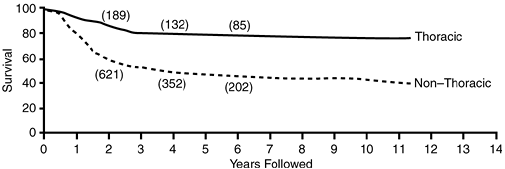 |
Fig. 189-4. Survival curves for thoracic (n = 227) and nonthoracic patients (n = 1,108) (p > 0.0001). Numbers above the curves represent cases with follow-up until or beyond the specified time points. From Morris JA, et al: Biological variables in thoracic neuroblastoma: a Pediatric Oncology Group Study. J Pediatr Surg 30:296, 1995. With permission. |
The indications for and timing of surgery for patients in the high-risk group are controversial. Initial surgical resection of large tumors is seldom recommended. Multimodal therapies include myeloablative chemotherapy or chemoradiation therapy followed by autologous bone marrow transplantation. Kletzel and associates (2002) reported improved survival statistics for patients with high-risk neuroblastoma treated with triple-tandem high-dose chemotherapy and peripheral blood stem cell rescue and local irradiation.
Ganglioneuroblastoma
Ganglioneuroblastoma is a malignant tumor but less aggressive than neuroblastoma. Grossly, the tumor is firm in consistency in two thirds of cases. Adam and Hochholzer (1981) reported that of the 48 lesions in which encapsulation was recorded, 69% were grossly encapsulated, 27% were partially encapsulated, and only 4% were without a capsule. Microscopically, ganglioneuroblastomas are composed of a mixture of mature ganglion cells and neuroblasts set in a pink fibrillar background (Fig. 189-7).
Overall, these tumors are less common than neuroblastomas, but in the thorax they appear to have approximately
P.2736
the same or a slightly greater incidence of occurrence than the neuroblastomas. In Adam and Hochholzer's (1981) review of the autonomic neurogenic lesions in the paravertebral sulci in the files of the AFIP, there were 65 neuroblastomas and 80 ganglioneuroblastomas. These lesions are reported to be seen more often in the older child and adolescents than are the neuroblastomas (see Table 189-3). However, in Adam and Hochholzer's series, one third of the patients were 2 years of age or younger, one half were 3 years of age or younger, and four fifths were 10 years of age or younger. Only 10 cases were seen between the ages of 12 and 20 years, and only three patients were over 20 years of age. Boys and girls under 10 years of age were affected equally, although a slight predominance was seen for girls over the age of 12.
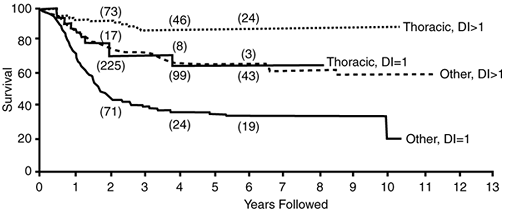 |
Fig. 189-5. Survival curves for thoracic (n = 114) and nonthoracic (n = 540) patients for whom the DNA index was recorded (stratified log-rank test; p > 0.0001). Numbers above the curves represent cases with follow-up until or beyond the specified time points. From Morris JA, et al: Biological variables in thoracic neuroblastoma: a Pediatric Oncology Group Study. J Pediatr Surg 30:296, 1995. With permission. |
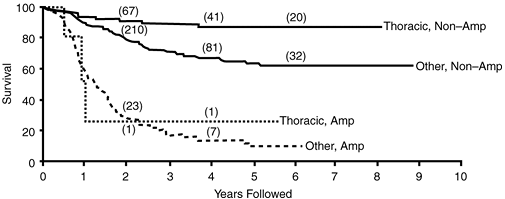 |
Fig. 189-6. Survival curves for thoracic (n = 84) and nonthoracic (n = 409) patients for whom N-myc amplification was recorded (stratified log-rank test; p = 0.003). Numbers above the curves represent cases with follow-up until or beyond the specified time points. From Morris JA, et al: Biological variables in thoracic neuroblastoma: a Pediatric Oncology Group Study. J Pediatr Surg 30:296, 1995. With permission. |
Table 189-9. Risk Groups for Neuroblastoma | |||||||||||||||||||||||||||||||||||||||||||||||||||||||||||||||||||||||||||||||||||||||||||||||||||||||||||
|---|---|---|---|---|---|---|---|---|---|---|---|---|---|---|---|---|---|---|---|---|---|---|---|---|---|---|---|---|---|---|---|---|---|---|---|---|---|---|---|---|---|---|---|---|---|---|---|---|---|---|---|---|---|---|---|---|---|---|---|---|---|---|---|---|---|---|---|---|---|---|---|---|---|---|---|---|---|---|---|---|---|---|---|---|---|---|---|---|---|---|---|---|---|---|---|---|---|---|---|---|---|---|---|---|---|---|---|
| |||||||||||||||||||||||||||||||||||||||||||||||||||||||||||||||||||||||||||||||||||||||||||||||||||||||||||
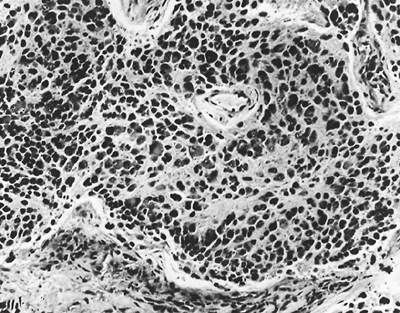 |
Fig. 189-7. Ganglioneuroblastoma composed of round neuroblastic cells and larger ganglion cells. From Marchevsky AM, Kaneko M: Surgical Pathology of the Mediastinum. New York: Raven, 1984. With permission. |
Approximately one half of these tumors are discovered as an asymptomatic mass on routine radiography of the chest. The other patients present with findings similar to those noted for neuroblastoma, although clinical evidence of excessive catecholamines is only infrequently noted and laboratory evidence of elevated VMA or HVA is only found in 12% of patients. Evidence of intraspinal canal extension is likewise uncommon.
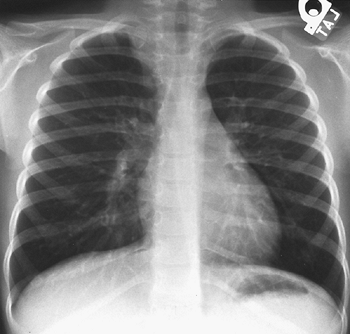 |
Fig. 189-8. Chest radiograph of a mass in the apical portion of the right paravertebral sulcus. Radiographic shadow is much more distinct than that of a neuroblastoma. On surgical excision, the tumor proved to be a ganglioneuroblastoma. |
P.2737
The radiographic features of the lobulated or oval paraspinal mass tend to be more distinct than the ghostlike shadow of the neuroblastoma (Fig. 189-8). Stippled calcification may be present. Chest wall changes [i.e., rib erosion or displacement according to Reed and associates (1978)] only occurs in 5% to 10% of patients. Intraspinal canal extension is, as noted, uncommon, but magnetic resonance imaging is indicated in all cases to rule it out.
Most children with ganglioneuroblastoma present with a solitary mass that can be resected. Complete evaluation of the patient and tumor analysis for biologic variables are critical to identify the more aggressive tumors. INSS staging and clinical risk group assignment should be made. Treatment is primarily surgical, although chemotherapy is indicated in the intermediate and high-risk groups.
Ganglioneuromas
Ganglioneuromas are benign tumors and represent the full maturation of the autonomic nervous tissue tumors. They may arise de novo or may follow maturation of a neuroblastoma. They account for approximately 42% of the autonomic neural crest tumors.
Pathology
Ganglioneuromas are frequently large, firm, well-circumscribed, encapsulated tumors arising in a paravertebral sulcus in the child, adolescent, or adult. The tumor usually is attached to a sympathetic or intercostal nerve trunk. Intraspinal canal extension can occur but is uncommon. On cut section, the tumor is yellowish to gray; Marchevsky and Kaneko (1992) state that it frequently has a whorled, trabeculated surface that may simulate a leiomyoma. Microscopic examination reveals mature ganglion cells, singly and in nests, in a stroma composed of Schwann cells and fibrous tissue (Fig. 189-9). Areas of degeneration are evident within the tumor. Calcification may or may not be present in these areas. The ganglion cells are large, and their cytoplasm may contain various inclusions. Ultrastructurally, dense-core vesicles have been identified by Bender and Ghatak (1978) and Yokoyama and associates (1973), as well as others.
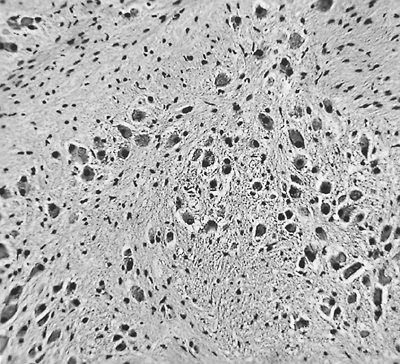 |
Fig. 189-9. Photomicrograph of typical ganglioneuroma. |
Clinical Features
Clinically, the patient may be asymptomatic, but patients with large lesions may present with cough, dyspnea, dysphagia, Horner's syndrome, and, occasionally, chest pain. Heterochromia iridis was reported by McRae and Shaw (1979) to be the result of sympathetic injury by the tumor involving the superior cervical ganglion. The age distribution is not dissimilar to that observed in patients with ganglioneuroblastomas (see Table 189-3). Elevated levels of VMA and HVA are observed infrequently. Chronic diarrhea also has been reported in association with these tumors by Mendelsohn (1979) and Trump (1977) and their associates. This is thought to be caused by the presence of vasoactive intestinal peptide, which can be localized to the cytoplasm of the ganglion cells by means of immunoperoxidase techniques.
Radiographic Features
The tumor presents as a solid, well-defined, ovoid or lobulated mass in one of the paravertebral sulci (Fig. 189-10). Stippled calcification was observed by Bar-Ziv and Nogrady (1975)
P.2738
in 50% of the patients studied. Rib erosion is uncommon and subtle in nature when observed. Intraspinal canal extension is uncommon but can occur, as noted by Bar-Ziv and Nogrady (1975) and Davidson and associates (1978). Thus, computed tomographic scanning or magnetic resonance examination is always indicated (Fig. 189-11).
 |
Fig. 189-10. Posteroanterior radiograph of the chest of an adolescent girl with an asymptomatic left superior mediastinal mass. The lesion proved to be a ganglioneuroma on histologic examination after surgical excision. |
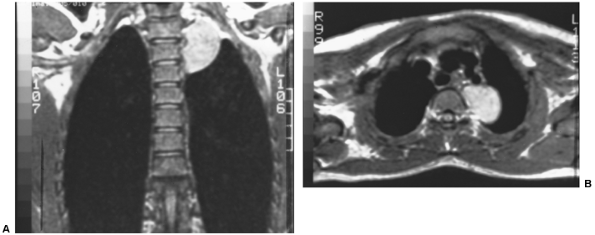 |
Fig. 189-11. A, B. Coronal and transverse MR images of the mass shown in Fig. 189-8 revealed no intraspinal canal extension. |
Treatment
Surgical excision is the treatment of choice and is curative. Marchevsky and Kaneko (1984) report that occasionally a regional lymph node may contain metastatic ganglioneuroma. Enzinger and Weiss (1988) believe these to be residual foci of neuroblastomas that have matured into a benign ganglioneuroma; subsequent recurrence of the disease is not seen in these patients.
Tumors of Nerve Sheath Origin
Benign Nerve Sheath Tumors
Both schwannomas (neurilemomas) and neurofibromas may occur in patients under 20 years of age. In the series reported by Reed and associates (1978), 15% of the neurogenic intrathoracic tumors seen in these age groups were of nerve sheath origin (see Table 189-3). These tumors are more common in patients between the ages of 16 and 20 years, although two cases of schwannomas were seen in children under the age of 10; five cases of nerve sheath origin were seen in this younger age group in Ribet and Cardot's (1994) series. The incidence of the two varieties is approximately equal, but the neurofibromas are more often seen in patients with von Recklinghausen's disease. Incidentally, neuroblastomas also are observed often in patients with this disease.
These benign nerve sheath tumors are found almost exclusively in the paravertebral sulci. Their pathologic and clinical features are the same as those of the adult population. These features, as well as their diagnostic investigation, treatment, and prognosis, are discussed in detail subsequently in this chapter.
Malignant Nerve Sheath Tumors
Malignant schwannoma (neurogenic sarcoma) rarely occurs in childhood. Isolated mention of its occurrence in series of childhood neurogenic thoracic tumors has been recorded, and one such patient was seen at the Children's Memorial Hospital in Chicago. This lesion's features are not dissimilar from those observed in adults; these features are discussed later in this chapter. It may be noted that Enzinger and Weiss (1988) as well as Keller (1984) and Ricci (1984) and their associates have described rare instances of malignant transformation of ganglioneuromas into malignant schwannomas. Also, malignant transformation of benign neurofibromas has been described, especially in children with von Recklinghausen's disease. Long-term observation over 10 to 20 years may reveal the occurrence of this event. A rapid increase in size of a benign lesion or the development of pain is indicative of malignant change.
Tumors of Neuroectodermal Origin
Two tumors of presumed neuroectodermal origin may occur in the mediastinum. One is the pigmented neuroectodermal tumor of infancy (melanotic progonoma) and the second is the malignant small cell tumor of the thoracopulmonary region (Askin's tumor) seen in the older child or adolescent.
P.2739
Melanotic Progonoma
Melanotic progonoma is seen most commonly in the upper or lower jaws, but infrequently may occur in the mediastinum where it can be confused with a pigmented neuroblastoma.
Marchevsky and Kaneko (1992) describe these tumors as dark gray or black tumors that histologically are composed of irregular spaces lined by cuboidal cells containing intracytoplasmic melanin and ultrastructural features of epithelium and melanocytes.
Misugi and associates (1965) and Williams (1967) considered these to be malignant tumors that recur in 15% of cases and that may metastasize widely. Treatment of this unusual tumor is local excision. The efficacy of other treatment modalities is unknown.
Askin's Tumor
Askin and associates (1979) described a malignant small cell tumor of the thoracopulmonary region in childhood that may present as a paravertebral mass, although it is more common in the posterior chest wall or even in the lung. Many believe that this is a peripheral neuroectodermal tumor, possibly arising from an intercostal nerve. This position is supported by the identification of neurosecretory granules and cell processes indicative of neuronal differentiation on electron microscopy. More important is the immunohistochemical demonstration of neuron-specific enolase in these tumors, as Linnoila and colleagues (1986) reported. These tumors also react variably to S-100. Cohen and Israel (1989) discussed the chromosomal translocations, such as rep (11, 22) (q24; q12), that are observed in these neuroectodermal tumors. They also presented evidence to differentiate these tumors from Ewing's sarcoma and stages III and IV neuroblastomas. In the former differential, it is to be noted that Ewing's sarcoma is negative for neuron-specific enolase in most instances, and that the few that have been examined by Gould and associates (1987) did not react to SY-38 for the presence of synaptophysin. In the latter situation, Cohen and Israel (1989) and Cohn and associates (1990) pointed out the significantly amplified protooncogene N-myc in neuroblastoma cell lines, as reported by Kohl and associates (1983), as opposed to a single copy of N-myc per cell in cell lines from peripheral neuroepithelial tumors, as reported by Thiele and colleagues (1987).
Askin's tumor (peripheral neuroectodermal tumor) is seen in older children and young adolescents and is discovered either as a chest wall mass or as a radiographic chest mass in a child with chest pain, cough, dyspnea, or other thoracopulmonary symptoms. Rib destruction is common (Fig. 189-12).
This tumor is three times more common in girls than in boys. Seven cases of this tumor have been observed in the Feinberg School of Medicine, Northwestern University complex of hospitals. Ohta (1995) and Sano (1995) and their colleagues reviewed the case reports of Askin's tumor in Japan, and each group added a case of its own. A total of 19 cases were collected. There were 12 adolescent and young women and 7 men. Thirteen of the patients were 15 years of age or younger and six were over 16 years of age. The youngest patient was 3 years of age and the oldest was 26 years of age. Takanami and Imamura (2002) reported the occurrence of this tumor in a 16-year-old boy and a 32-year-old woman, who are among the older individuals to develop Askin's tumor.
Wide en bloc excision is the standard therapy, followed by irradiation and chemotherapy whether the resection is complete or incomplete.
Cohen and Israel (1989), in a multimodality approach, used intensive induction chemotherapy (i.e., vincristine, doxorubicin, and cyclophosphamide) along with additional local control with either radiation therapy or wide surgical incision. After induction of remission, marrow-ablative chemotherapy, whole-body irradiation, and autologous bone marrow reimplantation are performed. The results of such an aggressive approach are yet unknown.
The lesion tends to recur locally, although distant metastases to lung or bones may be observed. Long-term survival is infrequent. Survival is often less than 1 year: Askin and colleagues (1979) noted a median survival of only 8 months. In the collected Japanese series, 5 resections were only partial and the other 14 were complete. The outcome was not recorded in two patients. All of the five patients with incomplete resections were dead within 2 years; five of the patients with complete resections were dead at the time of the report. The longest survivor survived for 41 months. The seven remaining patients were still alive at the time of the report, but none for longer than 2 years. The young man reported by Takanami and Imamura (2002) died 7 years after multiple local recurrences. The 32-year-old woman was still alive and well without evidence of disease at 7 years after the initial resection and chemotherapy.
Another Askin's tumor was reported in a 26-year-old Japanese-American woman by Baumgartner and co-workers (2001). The tumor was located in the mediastinum adjacent to the left pulmonary hilum. Despite aggressive therapy, the patient had a rapid downhill course and died 15 months after discovery of the disease. These investigators noted that Askin's tumor (a primitive neuroectodermal tumor) is now thought to be closely related to Ewing's sarcoma. A similar chromosomal translocation is seen in both, and Contesso and co-workers (1992) have noted marked similarity between Askin's tumor cells and those of the Ewing's sarcoma, both by immunohistochemical studies and electron microscopic features. Regardless of its cellular origin, Askin's tumor is most often rapidly fatal, and in collected series, only a 14% 6-year survival rate has been noted.
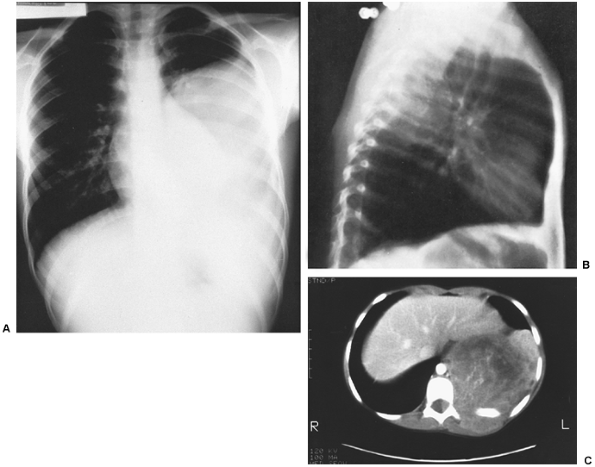 |
Fig. 189-12. A, B. Posteroanterior and lateral radiographs of the chest of a child with an Askin's tumor. C. CT scan shows invasion of the chest wall, destruction of the rib cage posteriorly, and extension of the tumor into the intraspinal canal. From Shields TW, Reynolds M: Neurogenic tumors of the thorax. Surg Clin North Am 68:645, 1988. With permission. |
P.2740
Tumors of the Paraganglionic System
The occurrence of biologically or nonbiologically active paraganglionic tumors in the mediastinum of children is rare. King and associates (1982) listed one malignant paraganglioma in their series of 188 mediastinal tumors in children.
The features of these tumors are not unlike those seen in adults. This subject is discussed in Chapter 191.
NEUROGENIC TUMORS IN ADULTS
Neurogenic tumors of the mediastinum in the adult, most often nerve sheath tumors or infrequently tumors from ganglionic cells, may be associated with any neurogenic structure within the chest, but most commonly are located in either the costovertebral sulcus arising from the sympathetic chain or one of the rami of an intercostal nerve (Fig. 189-13). Infrequently, either a phrenic nerve or one of the vagus nerves in the visceral compartment is the site of origin. Paragangliomas, biologically active or inactive, may occur in either the visceral compartment or the paravertebral areas. Rare neurologic tumors, such as granular cell tumors and melanotic schwannomas of both nerve sheath and ganglion cell origin, also may occur in the mediastinum.
When considered generically as mediastinal tumors, the benign and malignant neurogenic lesions historically are reported to be the most common of all mediastinal tumors in adults. This is no longer the case, and epithelial tumors of the thymus are encountered with much greater frequency at present (Table 189-10). Moreover, in some series, such as that reported by Cohen and associates (1991) from Walter Reed Hospital, the number of lymphomas now exceeds that of the neurogenic tumors as well.
The actual incidence of the neurogenic tumors is unknown, but historically they have been reported to account for 10% to 34% of all mediastinal tumors. In a collected series of a total of 2,412 mediastinal lesions (see
P.2741
Chapter 166), they accounted for 21% of all lesions. Teixeira and Bibas (1989) reported a similar overall incidence (Table 189-10). In a report of mediastinal neurogenic tumors in Japan, Miura and colleagues (1994) noted that in the data from three large series plus their own data, the overall incidence was 18.6%, whereas the incidence of epithelial tumors of the thymus was 25.3%. Presently, in most practices of adult general thoracic surgery, neurogenic lesions are encountered only infrequently.
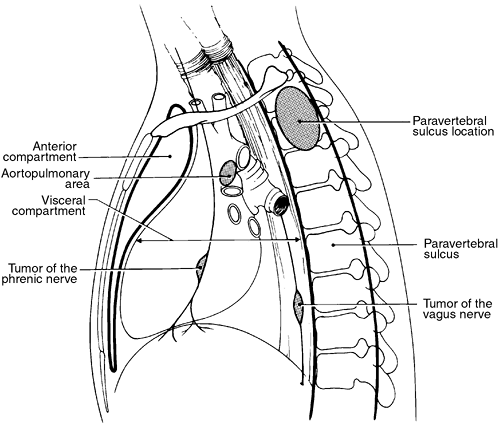 |
Fig. 189-13. Mediastinal compartments and usual location of neurogenic tumors: (1) paravertebral sulcus location; (2) aortopulmonary area of the visceral compartment; (3) tumor of the phrenic nerve in the visceral compartment; and (4) tumor of the vagus nerve in the visceral compartment. From Shields TW, Reynolds M: Neurogenic tumors of the thorax. Surg Clin North Am 68:645, 1988. With permission. |
Table 189-10. Types of Mediastinal Tumors Encountered | |||||||||||||||||||||||||||||||||||||||||||||||
|---|---|---|---|---|---|---|---|---|---|---|---|---|---|---|---|---|---|---|---|---|---|---|---|---|---|---|---|---|---|---|---|---|---|---|---|---|---|---|---|---|---|---|---|---|---|---|---|
| |||||||||||||||||||||||||||||||||||||||||||||||
Over a period of 7 years, we (1988) reported that only 10 thoracic neurogenic tumors were seen in six adults and one adolescent in a 1,200-bed complex of three university-affiliated hospitals. Eight of the nine tumors in the adults were benign, and one was malignant, as was the tumor in the adolescent.
The incidence of the various pathologic types of neurogenic tumors in adults encountered is different from that seen in children. In the adult, almost all of these tumors are derived primarily from the cells of the nerve sheaths (i.e., the Schwann cell). The Schwann cell tumors, as well as the tumors of the ganglionic cells of the spinal ganglia and of the autonomic, paraganglionic, and parasympathetic systems, arise from cells derived from the embryonic neural crest. Because of varying degrees of maturation and the diversity of cellular types formed, numerous classifications and names for the neurogenic tumors have been proposed. A relatively simple but reasonably complete classification for tumors seen in both adults and children is presented in Table 189-11.
Tumors of Nerve Sheath Origin
Benign lesions are classified as either a neurilemoma (benign schwannoma) or a neurofibroma. The malignant lesions are best termed malignant schwannomas but also are often referred to as neurogenic sarcoma.
Table 189-11. Neurogenic Tumors of the Thorax | |||||||||||||||||||||||||||||||||||
|---|---|---|---|---|---|---|---|---|---|---|---|---|---|---|---|---|---|---|---|---|---|---|---|---|---|---|---|---|---|---|---|---|---|---|---|
|
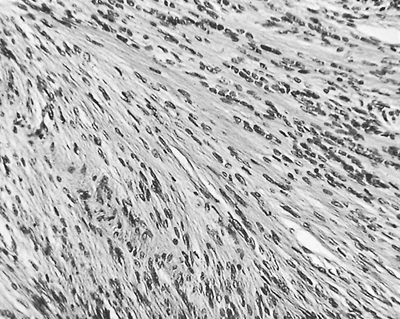 |
Fig. 189-14. Photomicrograph of a typical area of palisading of cells in an Antoni type A neurilemoma. |
P.2742
Neurilemoma (Schwannoma)
Neurilemomas are most often solitary encapsulated lesions in which the cells are identical to the syncytium of the nerve sheath or the Schwann cell. The cells proliferate within the endoneurium, and the perineurium forms the capsule. The cells line up parallel to and do not intertwine with the nerve fibers as they do in neurofibromas. Grossly, the tumor is well encapsulated, firm, and grayish tan. It appears to have a whorled pattern on cut sectioning. Areas of degeneration such as cyst formation or calcification may be present. In a series of 242 mediastinal tumors, Hirano and colleagues (1997) reported that 7 (all schwannomas) of 44 neurogenic tumors were cystic in nature (15.9%). Petkar and associates (2001) likewise have reported a cystic schwannoma. According to Weiss and Nickoloff (1993), uniformly intense immunostaining occurs for the S-100 protein in the cells of a neurilemoma. One of two cellular patterns may be present in the tumor: Antoni type A areas show a dense avascular spindle cell pattern with nuclear palisading (Fig. 189-14), and the Antoni type B areas, which are less orderly than Antoni A areas, show myxomatous changes that may be associated with cystic areas, vascular thickening, and frequent areas of hemorrhage (Fig. 189-15). The electron microscopic features of the two areas are different: the cells in the Antoni type A areas have numerous thin cytoplasmic processes emanating from the cell body with only a small amount of cytoplasm, whereas the cells in the Antoni type B areas lack these processes and have abundant cytoplasm. There appears, however, to be no clinical differences in the behavior of neurilemomas composed of either Antoni type A or B areas or of a combination of both.
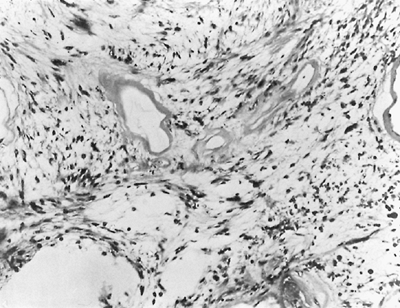 |
Fig. 189-15. Photomicrograph of neurilemoma of Antoni type B. Loose spindle cells in an edematous stroma with microcystic changes (original magnification 120). From Marchevsky AM, Kaneko M: Surgical Pathology of the Mediastinum. New York: Raven, 1984. With permission. |
Malignant transformation of a neurilemoma is rare; such a transformation, according to Crowe and associates (1956) and agreed with by Enzinger and Weiss (1988), is most likely to be in the range of 2%.
Plexiform Schwannoma
Plexiform schwannomas have been described in patients with neurofibromatosis (i.e., von Recklinghausen's disease). This variety of schwannoma consists of multiple tumor nodules separated by strands of nonneoplastic connective tissue. Characteristic Antoni type A areas with palisading and Verocay bodies, formed by two rows of cells with palisaded nuclei, are present and adjacent to hypocellular myxoid Antoni type B regions. Sheikh and associates (1998) reported that the plexiform neurilemoma is often multiple and is identified more commonly in patients with neurofibromatosis type 1 (peripheral) than in type 2 (central). The plexiform lesion is benign.
Cellular Schwannoma
A third type, or cellular schwannoma, has been described by Woodruff (1981), Fletcher (1987), and Lodding (1990) and their colleagues. This tumor may readily be thought by its histologic appearance to be malignant. According to Kornstein (1995), a fibrosarcomalike herring bone growth pattern is present. The spindle cells are slender and wavy. No nuclear palisading occurs, and no Verocay bodies are present. Some pleomorphin is present, but the tumor has low mitotic activity. Despite its pseudosarcomatous appearance, the tumor is benign, although some regard it as atypical and of uncertain malignant potential. It has a
P.2743
predilection to occur in the paravertebral areas. Fletcher and colleagues (1987) reported that these tumors rarely may recur but do not metastasize.
Melanotic Schwannoma of Nerve Sheath Origin
Enzinger and Weiss (1988) have noted that both the Schwann cells and melanocytes arise from the neural crest, and that some melanocytic differentiation with the production of pigment may be seen in some Schwann cell tumors. Such pigment possesses the tintorial and ultrastructural features of dermal melanin. As a rule, the small quantities of pigment impart no gross color change to the schwannoma. However, a few grossly pigmented (bluish black) nerve sheath schwannomas have been reported to arise within the paravertebral sulcus region as well as in the spinal canal.
The literature is slightly confusing on melanotic schwannomas. Millar (1932) began the confusion when he described a malignant pigmented posterior mediastinal tumor in a 34-year-old man. When this patient came to autopsy, the tumor was widely disseminated, and it appeared to arise from the seventh ganglion of the left sympathetic chain. Careful examination of the skin and eyes excluded the presence of a melanoma. Millar concluded, on the basis of the histology, that this tumor originated from the ganglion cells. Since this initial case report, it has become clear that pigmented posterior mediastinal tumors fall into two categories. One is a malignant pigmented tumor of uncertain histogenesis, but that frequently is associated with a sympathetic ganglion, and the other is a melanotic schwannoma. As a rule the melanotic tumors of probable ganglion cell origin are highly malignant, in contrast to the benign behavior of the melanotic schwannomas of nerve sheath origin.
Bjornebae (1934) first described a benign melanotic nerve sheath schwannoma occurring in a peripheral nerve, but the first reported example of this tumor occurring in the paravertebral sulcus was by Mandybur (1974). Several other cases have been recorded by Bagchi (1975) and Paris (1979) and their associates. All of these aforementioned tumors extended into the spinal canal. Kayano and Katayama (1988) reported one arising from a sympathetic ganglia that did not extend into the spinal canal. The tumor in this case expressed the ultrastructural and immunohistochemical features of Schwann cell derivation (i.e., reactivity to S-100 protein and pericellular heminin positivity) as described in similar cases by Font and Truong (1984) and Miettinen (1987). In the latter case, the tumor arose in the paravertebral sulcus, but its actual site of origin was not given. Abbott and colleagues (1990) reported a similar benign melanotic schwannoma arising from the sympathetic chain. In addition to these paravertebral lesions, a number of similar tumors have been reported by Graham and co-workers (1976) and others (see Reading References) confined to the epidural area of the spinal canal. Grossly, the tumors are bluish black. Histologically, they are composed of pigmented spindle cells arranged in interlacing bundles and fascicles. Some of the cells may not contain pigment granules. A tendency toward palisading of the nuclei may be present. Psammomatous calcifications may be present. On electron microscopy, the tumors show cells with melanosomes in different stages of development. The tumor cells also show ultrastructural and immunohistochemical features as noted that are suggestive of Schwann cells. These tumors react immunohistochemically to S-100 protein and also express the melanoma-associated marker HMB-45. These benign melanotic schwannomas behave like neurilemomas. Local recurrence may occur, but these tumors have not been reported to metastasize.
Carney's Heritable Disorder.
Carney (1990) has described a distinctive heritable disorder consisting of psammomatous melanotic schwannomas associated in 55% of patients with myxomas, spotty pigmentation, and endocrine overactivity (i.e., Cushing's syndrome), Sertoli's cell tumor, or acromegaly. The myxomas occur in the heart, skin, and breast. The melanotic schwannomas occur in multiple sites (i.e., spinal nerve roots, chest wall, stomach, or bone). Histologically, the schwannomas contain melanin, less frequently psammoma bodies, fat, and rarely metaplastic bone. Eighty-seven percent of the tumors studied by Carney (1990) were benign and 13% proved to be malignant with subsequent metastases. The cells are positive for S-100 and vimentin; HMB-45 reactivity was not studied.
Neurofibroma
In contrast to the neurilemoma, the Schwann cells present in a neurofibroma proliferate in a disorderly fashion, and the cells become entwined with the nerve fibers in a disorganized manner. The tumors are pseudoencapsulated. Grossly, once the pseudocapsule is cut, the tissue surface is white to grayish yellow and lacks the degenerative changes seen with a neurilemoma. Histologically, a tangled network of elongated Schwann cells is seen, with dark-staining nuclei intermingled with neurites (Fig. 189-16). On electron microscopy
P.2744
the cells appear elongated with thick cytoplasmic processes interspersed with myelinated and unmyelinated axons in a collagenous stroma. Variable and less intense S-100 protein immunostaining occurs in the cells of the neurofibroma, in contrast to the more intense staining in the cells of the neurilemomas. Weiss and Nickoloff (1993) reported that CD34 (hematopoietic progenitor cell reactivity) is expressed by a distinctive cell population in nerve sheath tumors, but the positive cells are distinct from Schwann cells, fibroblasts, and perineural cells. The CD34 reactivity was identified in 14 of 17 neurofibromas, 10 of 10 Antoni B zones in neurilemomas, but negative in all Antoni A zones and negative in the one melanotic schwannoma evaluated.
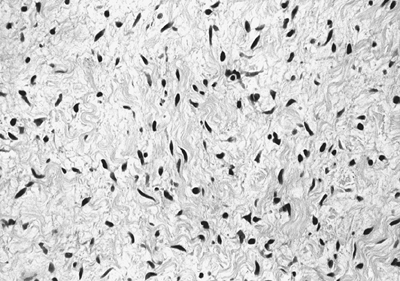 |
Fig. 189-16. Photomicrograph of typical neurofibroma. Interlacing bundles of cells with dark wavy nuclei are separated by wavy strands of collagen (original magnification 250). |
On occasion in a patient with von Recklinghausen's disease, an admixture of both a neurilemomatous and neurofibromatous element may be identified in the same tumor. This has undoubtedly led to confusion as to the classification and the reported varying incidence of neurilemomas and neurofibromas evident in the reported literature.
The more common characteristics of each of the aforementioned benign tumors are listed in Table 189-12. Malignant transformation of a neurofibroma is more common than the incidence observed with a neurilemoma. The occurrence of the former is seen more often in patients with von Recklinghausen's disease than in patients with the sporadic occurrence of a neurofibroma. The overall incidence nonetheless is relatively low (approximately 4% to 5%).
Plexiform Neurofibroma
The plexiform neurofibroma is a variety of the neurofibromas. It is defined as a diffuse fusiform enlargement or multiple masses, or both, along the course of a peripheral nerve trunk. Histologically, the lesion shows a convoluted cluster of nerve fibers similar to a solitary neurofibroma. It is associated with the clinical manifestations of neurofibromatosis (von Recklinghausen's disease) or a family history of the disease. This lesion occurs most commonly outside of the thorax but can occur along either sympathetic nerve trunks in the paravertebral sulci or along either the vagus or phrenic nerves in the visceral compartment.
Granular Cell Tumors
Granular cell tumors are uncommon, generally benign lesions that occur in multiple sites throughout the body. Fust and Custer (1949) suggested that granular cell tumors could be of neural origin. This concept was supported but not conclusively proved by electron microscopic studies of Fisher and Wechsler (1962) and Mackay (1968) and Khansur (1985) and their associates. However, additional supporting evidence of a Schwann cell origin has been the detection of neuroectodermal protein (S-100) by Armin (1983) and Aisner (1988) and their associates. They are most common in the skin and subcutaneous tissue and the tongue. They also have been reported in the bronchus; this subject has been reviewed by Oparah and Subramanian (1976). Postlethwait (1986) collected 49 cases reported in the esophagus.
Rosenbloom and co-workers (1975) were the first to describe a granular cell tumor associated with the thoracic sympathetic chain in the left costovertebral sulcus in an 11-year-old boy. Aisner and associates (1988) reported a case in an adult of bilateral granular cell tumors in the superior
P.2745
portion of the paravertebral sulci (Fig. 189-17). Almost all granular cell tumors are benign, but according to Colberg (1962), 3.5% may prove to be malignant. Enzinger and Weiss (1988) reported the incidence of malignancy to even be lower, only 1% to 2% of all granular cell tumors.
Table 189-12. Comparison of Neurilemoma and Neurofibroma | ||||||||||||||||||||||||||||||||
|---|---|---|---|---|---|---|---|---|---|---|---|---|---|---|---|---|---|---|---|---|---|---|---|---|---|---|---|---|---|---|---|---|
| ||||||||||||||||||||||||||||||||
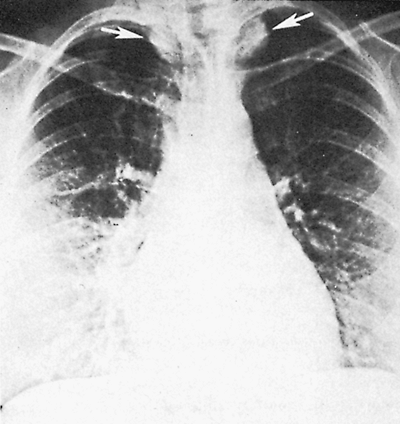 |
Fig. 189-17. Posteroanterior radiograph of chest reveals bilateral apical paravertebral masses (arrows) that on resection proved to be a granular cell tumor. From Aisner SC, et al: Bilateral granular cell tumors of the posterior mediastinum. Ann Thorac Surg 46:688, 1988. With permission. |
Malignant Schwannoma
Although the most common malignancy of peripheral nerve origin, malignant schwannoma remains one of the most poorly defined of all soft tissue sarcomas. Its overall incidence remains obscure, but in the setting of the neurogenic tumors of the mediastinum, it probably accounts for less than 1% to 2% of all such tumors encountered. It most frequently occurs in patients with von Recklinghausen's disease, but Sorenson and colleagues (1981) reported that only approximately 4% of patients with this disease develop malignant schwannomas. It is even less likely to develop de novo in unaffected persons. When it occurs in association with von Recklinghausen's disease, Guccion and Enzinger (1979) noted that it is usually after a long latent period of 10 to 20 years. It also may occur in a nongenetic association as a late complication of therapeutic or occupational irradiation after a latent period of 15 years, according to the studies of Ducatman and Scheithauer (1983) and Ducatman and associates (1986). Thus, long-term surviving patients previously treated for a mediastinal lymphoma or malignant germ cell tumor may be potential candidates for the late development of a malignant schwannoma in the irradiated field.
Most malignant schwannomas (neurogenic sarcomas) are large, and the cut surfaces are white or flesh colored with areas of macroscopic hemorrhage or necrosis, or both. They may or may not arise from a typical-appearing neurofibroma. Microscopically, these tumors resemble fibrosarcomas, but the cells tend to mirror the features of normal Schwann cells but with irregular contours (Fig. 189-18). In profile, the nuclei are wavy, but when viewed head on, they are asymmetrically oval. The cellular arrangement is varied, and palisading is infrequent. According to Enzinger and Weiss (1988), palisading occurs in less than 10% of cases and most often is focal. The other histologic microscopic and electromicroscopic features are well described by Enzinger and Weiss (1988). Fifty percent to 90% of the tumors are reactive to S-100 protein; this reactivity may help in its differentiation from other soft tissue sarcomas. Wick and associates (1987) have identified myelin basic protein in approximately one half of malignant schwannomas. Neuron-specific enolase and neurofilament proteins
P.2746
have been identified in these tumors by Matsunou and colleagues (1985).
 |
Fig. 189-18. A. Photomicrograph of malignant schwannoma with cells being organized into fascicles, similar to a fibrosarcoma (original magnification 40). B. Malignant schwannoma showing cells whose nuclei are wavy when viewed in profile and oval when viewed en face (original magnification 250). |
Ducatman and Scheithauer (1984) have described the occasional occurrence of divergent differentiation in malignant neurogenic tumors. Foci of rhabdomyosarcoma, osteosarcoma, chondrosarcoma, and angiosarcoma have been identified. A neurogenic sarcoma containing areas of rhabdomyosarcoma has been called a triton tumor. Infrequently, these divergent lesions have occurred in the mediastinum in patients with neurofibromatosis. Recently, Bose and associates (2002) reported the occurrence of a malignant triton tumor of the right vagus nerve in a 35-year-old man with associated neurofibromatosis type 1. At the time of the report, the patient was alive and well 18 months after resection.
Clinical Features of Tumors of Nerve Sheath Origin
Approximately 98% to 99% of the neurogenic mediastinal tumors in adults are benign. In addition to the aforementioned data of Sorenson and colleagues (1981), Davidson (1978) and Reed (1978) and their colleagues also reported the incidence of malignancy to be in the range of 1% to 2%.
The benign lesions are identified in the young and middle-aged adult. Women are affected more often than men, although in patients with von Recklinghausen's disease, the lesions are more common in men. The neurilemoma is the more common of the two tumors. This tumor is most often solitary but may occasionally be multiple. Multiple lesions are more common in patients with von Recklinghausen's disease, occurring in as many as 10% of such patients, but most often multiple tumors are of the neurofibromatous type. Even so, most neurofibromas are also solitary.
Although it is generally believed that the tumors associated with von Recklinghausen's disease are all neurofibromas, some of the individual tumors may be pure neurilemomas. In fact, in an early review by Stout (1935), 18% of the neurilemomas were associated with this syndrome, and Enzinger and Weiss (1988) agree with this observation. At times, an admixture of neurofibroma and neurilemoma may occur in the same tumor. This was evident in one adult patient of one of us (TWS) with von Recklinghausen's disease in whom multiple intrathoracic as well as brachial plexus lesions were removed that revealed histologic features of both tumor types.
The nerve sheath tumors in the thorax are most often found in either costovertebral sulcus. They may occur infrequently in the visceral compartment as tumors of either the vagus or phrenic nerves. They also may arise from the brachial plexus or from an intercostal nerve. These tumors are most often asymptomatic (92% to 94%). Some of the benign tumors may cause symptoms because of pressure on an adjacent nerve; thoracic pain, Horner's syndrome, hoarseness, and upper extremity weakness or pain are occasionally observed. Infrequently dyspnea, cough, or other respiratory symptoms may be noted. Superior vena cava obstruction also has occurred with large tumors. A few may cause symptomatic extradural compression of the spinal cord as the result of growth through an intervertebral foramen into the spinal canal. Akwari and associates (1978) noted that such hourglass growth may be observed in approximately 10% of all benign nerve sheath tumors. It is more important to emphasize as the aforementioned investigators reported that the intraspinal canal extension may be asymptomatic in 30% to 40% of these patients at the time of initial diagnosis.
Oosterwijk and Swierenga (1968) reported that a benign nerve sheath tumor infrequently may be located in the visceral compartment when the tumor arises from a phrenic or vagus nerve. They reported involvement of one of these nerves in 3 of their 111 patients, an incidence of 2.7%. Strickland and Wolverson (1974) reported three cases of patients with vagal neurogenic tumors and reviewed 15 of the 21 cases that had previously been reported in the literature. No reference to the incidence of this site of involvement was given. Although the exact number cannot be discerned from the data of Reed and associates (1978), it was inferred that 8% of the neural tumors in the thorax arose from either the vagus or phrenic nerves. These were all nerve sheath tumors, and the more common was a neurofibroma, occurring in 8 of 13 tumors. Dabir and associates (1990) reviewed the literature several years later and reported a total of 27 patients plus 2 of their own with nerve sheath tumors of the vagus nerves; they did not include the reports of Osada (1979) or Mizuno (1981) and their colleagues from Japan. Thus, the overall number of cases in actuality is greater than the number of cases they reported at that time. Subsequently, Shirakusa and co-workers (1989) reviewed 17 of the 19 cases that had been reported in the Japanese literature, and numerous case reports, such as those by Davis (1991), Katoh (1995), and Sheikh (1998) and their colleagues, as well as others, have been published. From all these data it may be concluded that the left vagus nerve is involved more commonly than the right vagus nerve. The former is involved most often in its proximal portion in the thorax above or at the region of the aortic arch. Hoarseness occurs in approximately 20% of the cases and rarely, when the tumor is large or malignant, the trachea may be involved, as noted by Katoh and associates (1995). The tumor is slightly more often a neurofibroma than a schwannoma and either, especially in patients with neurofibromatosis, may be of the plexiform variety. Neurogenic sarcoma does occur. Maebeya and colleagues (1993), as well as Singer (1995), have reported the occurrence of a malignant schwannoma of the intrathoracic vagus nerve. Nerve sheath tumors of the phrenic nerves occur much less frequently than do those of the vagal nerves. Only a few cases, such as that of Ewy and associates (1995), have been recorded in the English literature. However, Yamashita and colleagues (1996) reported one patient with a neurilemoma
P.2747
of the right phrenic nerve and collected 13 other neurogenic tumors of the phrenic nerve that had been reported in the Japanese-language literature. All of these lesions were schwannomas, but neurofibromas and neurogenic sarcomas can occur as well. In the aforementioned Japanese report, the phrenic nerve tumors occurred equally in the right or left nerve and equally in women as in men.
The small percentage of malignant nerve sheath tumors tend to occur in either younger or older individuals than those with benign lesions and tend to occur in patients with von Recklinghausen's disease. The neurofibrosarcomas, particularly those associated with neurofibromatosis type 1, according to Hajdu (1993), are seen at an average age of 34 years. A predilection for young women exists, and they are more commonly seen in the trunk rather than in the thorax. These tumors are aggressive. In contrast, the malignant tumors arising from schwannomas are seen at a later age and are much less aggressive in their clinical behavior. Erosion of adjacent bony structures associated with pain is not an unusual finding (Fig. 189-19). Growth into the spinal canal may occur. Lymph node metastases are rare, but metastases to distant sites may be observed in a high percentage of cases.
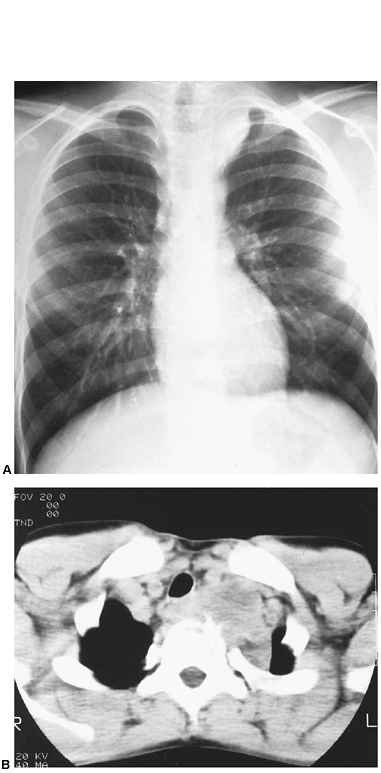 |
Fig. 189-19. A. Posteroanterior chest radiograph of a patient with a malignant schwannoma and severe back pain. B. CT scan reveals extensive involvement of adjacent vertebral body. From Shields TW, Reynolds M: Neurogenic tumors of the thorax. Surg Clin North Am 68:645, 1988. With permission. |
Radiographic Features of Nerve Sheath Tumors
Characteristically, the radiographic appearance of a benign lesion is that of a solitary smoothly rounded mass usually in the upper one third or one half of either paravertebral sulcus abutting the vertebral column (Fig. 189-20). However, the mass may be at any level. Lobulation is occasionally present, and adjacent bony changes (e.g., erosion, splaying of the ribs, or enlargement of an intervertebral foramen) may be recognized (Fig. 189-21). Calcifications may be seen in the neurilemoma, and cystic changes may be identified occasionally in both the former tumor, as noted by Hirano and colleagues (1997) and in neurofibromas, as reported by Shin and associates (1988). The malignant lesions tend to be more diffuse and irregular; erosion of adjacent bony structures is common.
The rare tumors of the vagus or phrenic nerves have no characteristic radiographic features. They are identified initially as a mass in the superior portion of the visceral compartment, most often in the region of the aortic arch on the left (Fig. 189-22). Bourgouin and associates (1988) suggested that computed tomographic (CT) examination of any paraaortic mass in a patient with neurofibromatosis may be most helpful in supporting the diagnosis of a plexiform neurofibroma. Low attenuation of the tumor on CT scan (14 20 Hounsfield units), ill-defined margins with the adjacent fat, and the mass surrounding the adjacent great vessels are features that are characteristic of the lesion. Also, multiple small tumorlike enlargements along the course of the involved nerve further support the diagnosis.
However, CT's role is more important in the evaluation of lesions in the paravertebral area to rule out intraspinal canal extension (Fig. 189-23). Formerly, spine films were obtained to visualize the intervertebral foramen in the vicinity of the tumor for the purpose of evaluating the size of the adjacent intervertebral foramen, but now most clinicians forego this study, and a CT scan is suggested as the initial step in the patient's evaluation.
When a paravertebral tumor is found to have extended into the spinal canal, myelography or magnetic resonance
P.2748
P.2749
(MR) imaging may be performed to determine the longitudinal extent of the lesion within the canal (Fig. 189-24). It has been suggested that in patients with demonstrated intraspinal canal extension located in the lower half of the thorax, the site of origin and course of the artery of Adamkiewicz (Figs. 189-25 and 189-26), which is one of the sources of the anterior spinal artery, be demonstrated by angiography. The knowledge obtained permits the surgeon to protect this vessel from injury during the removal of the tumor. However, this advantage may be outweighed by the possible neurotoxic danger of the contrast media on the spinal cord. This toxicity may be reduced to an acceptable level with the use of meglumine iothalamate (Conray-60, Mallinckrodt, St. Louis, MO). Shetty and Magilligan (1986) and others have found this to have minimal neurotoxic
P.2750
effects compared with other contrast agents. Digital subtraction studies also may be helpful (Fig. 189-27).
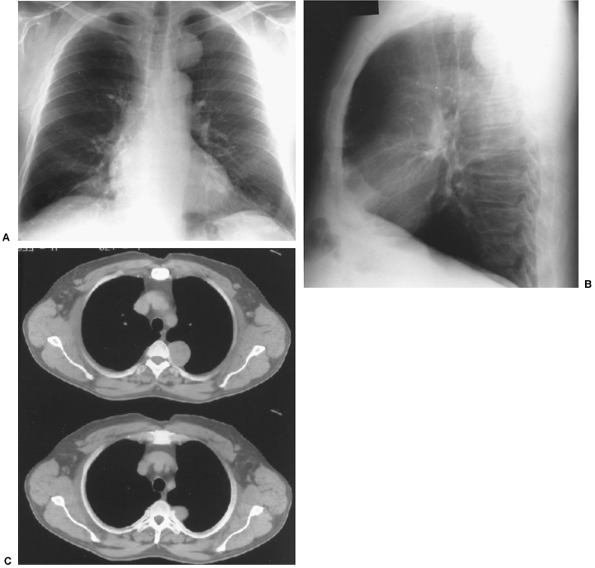 |
Fig. 189-20. A, B. Posteroanterior and lateral chest radiographs reveal a typically located neurilemoma in the left paravertebral sulcus. C. CT scan reveals no intraspinal canal extension. |
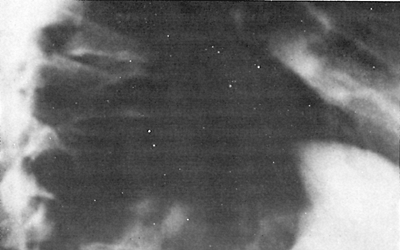 |
Fig. 189-21. Enlarged eroded intervertebral foramen from extension of a neurofibroma into the spinal canal. From Shields TW, Reynolds M: Neurogenic tumors of the thorax. Surg Clin North Am 68:645, 1988. With permission. |
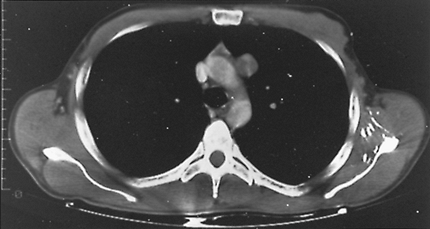 |
Fig. 189-22. CT scan of a middle-aged man with von Recklinghausen's disease who had multiple paravertebral neurogenic tumors removed previously. A newly developed neurogenic tumor of the left vagus nerve is evident at the level of the aortic arch. |
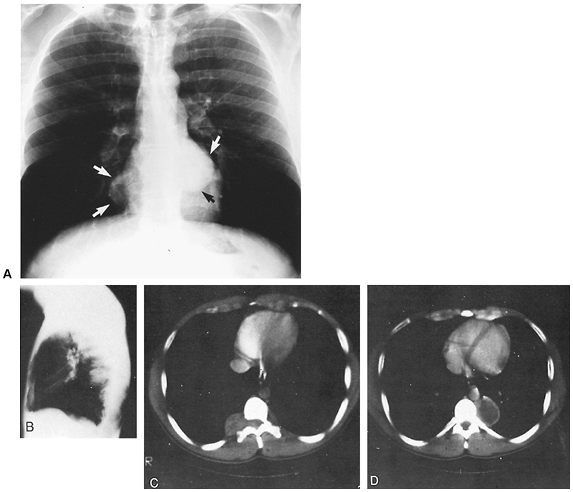 |
Fig. 189-23. Young adult man with asymptomatic bilateral paravertebral neurofibromas in association with von Recklinghausen's disease. A. Posteroanterior radiograph shows large left-sided and smaller right-sided tumors (arrows). B. Lateral radiograph reveals the larger left-sided lesion. C. CT scan reveals intraspinal canal extension by the smaller right-sided tumor. D. CT scan reveals absence of intraspinal extension by the larger tumor on the left. From Shields TW, Reynolds M: Neurogenic tumors of the thorax. Surg Clin North Am 68:645, 1988. With permission. |
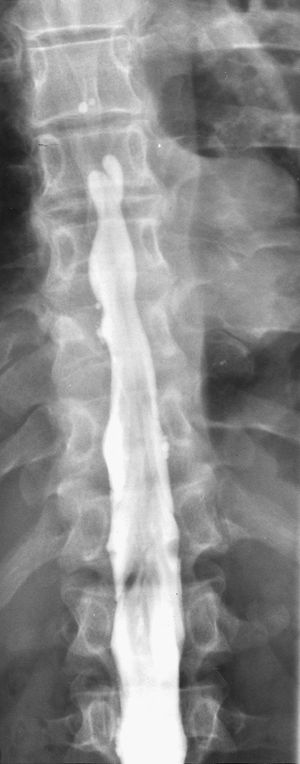 |
Fig. 189-24. Myelogram reveals only minimal extradural compression caused by the intraspinal canal growth of the right-sided neurofibroma shown in Fig. 189-23. Erosion of an adjacent vertebral pedicle is well visualized. No erosion of pedicles adjacent to the left-sided tumor is demonstrated. |
 |
Fig. 189-25. Schematic illustration of the artery of Adamkiewicz supplying the inferior portion of the anterior spinal artery. From Shields TW, Reynolds M: Neurogenic tumors of the thorax. Surg Clin North Am 68:645, 1988. With permission. |
 |
Fig. 189-26. Variation in the origin of the artery of Adamkiewicz from the intercostal vessels of the thoracic aorta. From Shields TW, Reynolds M: Neurogenic tumors of the thorax. Surg Clin North Am 68:645, 1988. With permission. |
In addition to the advantages of magnetic resonance imaging in delineating the intraspinal canal extension of dumbbell paravertebral neurogenic tumors, Sakai and associates (1992) suggested that the use of T1- and T2-weighted images might reveal different features of common cell types, but this would seem to be of little clinical importance in treating these patients.
Treatment of Nerve Sheath Tumors
The treatment of the benign lesions is simple enucleation of a neurilemoma or a more extensive excision of a neurofibroma with resection of an adjacent nerve structure as required. The procedure may be accomplished through a standard posterolateral thoracotomy or a video-assisted thoracoscopic removal as reported by Landreneau (1992), Naunheim (1993), and Ishida (1996) and their colleagues, among the many other reports in the 1990s. Riquet and associates (1995) reported the resection of 18 of 26 mediastinal tumors by the videothoracoscopic technique. They believe the contraindications to its use are a large tumor (>6 cm in diameter), spinal artery involvement, intraspinal extension of the tumor, and a middle mediastinal location. Many do not agree, especially with the last two contraindications. Higashiama and associates (1993), as well as Tsunezuka and Sato (1998), recommended that after the mobilization of the intraspinal extension of a dumbbell neurogenic tumor, the intrathoracic and previously mobilized intraspinal extension be removed by the video-assisted thoracoscopic technique. Also, both benign and malignant neurogenic tumors of the vagus nerve have been removed by this technique by Nakamura and colleagues (1997) and Singer (1995), respectively. In the latter case, tumor implant
P.2751
occurred in the incision for failure to place the resected specimen in a protective bag before extraction through the chest wall. A subsequent local excision of the implant appears to have been successful. Occasionally, a peripheral neurologic defect may be noted postoperatively. This is most common with lesions high in the apex of the paravertebral sulcus, when Horner's syndrome caused by injury of the stellate ganglion may be observed. Excision of neurogenic tumors of the upper portion or at the level of the left recurrent nerve take-off of the left vagus nerve frequently results in paresis of the recurrent nerve and subsequent paralysis of the left vocal cord with the occurrence of hoarseness. Shirakusa and colleagues (1989) noted that three of nine patients with lesions of the left vagus nerve in this location were hoarse preoperatively and the six others became so postoperatively. Davis and associates (1991) also reported this complication, but excellent palliation was obtained with Teflon injection into the affected vocal cord to return it to a midline position. However, the complication has been avoided in the patients recorded by Dabir (1990) and Nakamura (1997) and their associates, as well as by Singer (1995) and others. Otherwise, operative morbidity and mortality should approach zero.
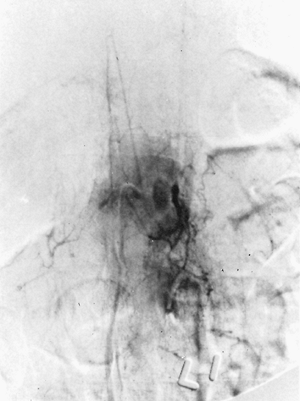 |
Fig. 189-27. Spinal artery angiogram, digital subtraction study. The characteristic loop of the great anterior medullary artery, the artery of Adamkiewicz, is clearly seen. From Grillo HC, Ojemann RG: Mediastinal and intraspinal dumbbell neurogenic tumors. In Delaware NC, Eschapasse H (eds): International Trends in General Thoracic Surgery. Vol. 5: Frontiers and Uncommon Neoplasms. St. Louis: CV Mosby, 1989. With permission. |
Failure to recognize intraspinal canal extension of the tumor, however, can be disastrous. Manipulation of the extension from within the thorax or leaving behind the intraspinal canal growth may lead to hemorrhage within the spinal canal with subsequent spinal cord compression or even direct injury to the cord. Either may result in a Brown-S quard syndrome or even a complete physiologic transection of the cord.
When extension into the spinal canal has been demonstrated preoperatively, a one-stage, two-team approach is indicated to first remove the intraspinal canal extension by the appropriate hemilaminectomy and then remove the intrathoracic portion of the growth. The various approaches and results of the one-stage procedure have been described by Le Brigand (1973), and Akwari (1978), Irger (1975, 1980), and Grillo (1983, 1989) and their colleagues. The technique of the procedure is described in Chapter 190.
Melanotic schwannomas almost always require the aforementioned surgical approach. Most reported cases have extended into the spinal canal, except those reported by Miettinen (1987), Kayano and Katayama (1988), and Abbott and colleagues (1990).
The treatment of the rare granular cell tumor in the paravertebral area is surgical excision as is carried out for the other benign tumors of nerve sheath origin.
Lesions of the vagus or phrenic nerves are excised, attempting to preserve the function of the affected nerve. An asymptomatic plexiform neurofibroma (the diagnosis supported by the characteristic CT finding) of either of these nerves may not need to be resected.
In patients with malignant lesions, resection is primarily to prevent or to relieve compression of the spinal cord. Complete removal generally is not possible. Stabilization of the vertebral column may be necessary after extensive resection. Postoperative radiation therapy may be given to attempt to control the residual local disease. The role of chemotherapy is undetermined. However, doxorubicin or dimethyltriazenoimidazole carboximide may be tried in patients with disseminated disease.
Prognosis of Nerve Sheath Tumors
Recurrence of a benign lesion is unusual, although additional neurofibromas or even neurilemomas may develop in patients with von Recklinghausen's disease. Rarely, a late malignant schwannoma may be observed in a patient with von Recklinghausen's disease.
It is the general impression that patients with malignant schwannoma in the paravertebral regions do poorly. Total excision is usually impossible and even when accomplished, local recurrence is common. Guccion and Enzinger (1979) observed that patients with malignant schwannoma of any site complicating von Recklinghausen's disease experienced
P.2752
a local recurrence rate of 78% and a 63% incidence of distant metastases. The common metastatic sites recorded were lung, liver, subcutaneous tissue, and bone. Most of these manifestations occur within 2 years of treatment. Patients with sporadic malignant schwannomas, in the absence of von Recklinghausen's disease, appear to do better than those patients who have von Recklinghausen's disease. Both Guccion and Enzinger (1979) and Sorensen and associates (1986) reported an approximate long-term survival of 50% of cases. Even higher survival rates (75%) have been reported in the earlier literature, as noted by Marchevsky and Kaneko (1992). Whether these data can be translated to those patients with intrathoracic malignant schwannoma is unknown.
Tumors of Sympathetic Ganglia
The majority of tumors of the sympathetic ganglia occur in infants and children. This aspect of these tumors was discussed extensively earlier in this chapter.
Ganglioneuromas
Ganglioneuromas are benign tumors seen predominantly in children older than 3 or 4 years of age. Ganglioneuromas may occur in young and even middle-aged adults. Of the 38 ganglioneuromas in Reed and associates' (1978) series of 160 neural thoracic tumors from the AFIP, almost half (47%) were present in patients over 20 years of age. Approximately half of these occurred in the third decade of life, and the other half in the fourth decade. Only two tumors were observed in patients over 40 years of age, and none occurred after the age of 50. Similar data were recorded by Ribet and Cardot (1994). Of the 134 neurogenic tumors reported in their series, 35 were ganglioneuromas and half of these occurred after the age of 15 years; only two patients between the ages of 45 and 54 years had a ganglioneuroma. These tumors present as large round or oval paravertebral masses. Bar-Ziv and Nogrady (1975) reported the frequent finding of areas of stippled calcification in these lesions. In contrast to the nerve sheath tumors, intraspinal extension is infrequent. Enzinger and Weiss (1988) have described rare instances of malignant transformation of these tumors into malignant schwannoma. Treatment is surgical excision.
Neuroblastoma and Ganglioneuroblastoma
Neuroblastomas are primarily malignant tumors of infants and young children. The mediastinal compartments and the paravertebral spaces are frequently involved, as are the more common areas below the diaphragm. Infrequently, this tumor occurs in the adult population, but most of these neuroblastomas occur below the diaphragm and only rarely are found in the mediastinum. The reviews of Bronson (1952) and Kilton and associates (1976) initially confirmed these observations. The series published by Reed and colleagues (1978) from the AFIP recorded that only 2 of 18 thoracic neuroblastomas (11%) occurred in patients over 20 years of age. Both patients were only 21 years old. The 11% incidence of neuroblastoma in adults in this series is undoubtedly artificially high because of the patient base. Subsequently, Hoover and co-workers (1988), in reviewing five other series, identified 40 patients with a primary thoracic neuroblastoma only, 1 of which occurred in an adult who was 27 years of age, for an incidence of only 2.5% (see Reading References Neuroblastoma). In addition to this one patient included in the series of Eklof and Gooding (1967), Hoover and co-workers (1988) presented an additional case in a 57-year-old man with a neuroblastoma in the retrocardiac region of the visceral compartment extending into or arising from the right paravertebral sulcus. Lastly, it is of interest to note that in Ribet and Cardot's (1994) series of neurogenic tumors of the thorax, no patient over the age of 14 years had either a neuroblastoma or a ganglioneuroblastoma.
However, individual case reports of thoracic neuroblastoma have been published that have added to our knowledge relative to these tumors in adults. Buthker (1964) and Hutchinson (1968) and their associates each reported a neuroblastoma occurring in the anterior mediastinum of an elderly and a middle-aged woman, 67 and 51 years of age, respectively. Griff and Griff (1968) reported a neuroblastoma in the paravertebral area (so-called posterior mediastinum), and lastly, two tumors simply were stated to be in the thorax (see Reading References Neuroblastoma). In 1986, Kaye and colleagues reported on one patient with a neuroblastoma located in the anterior mediastinum that extended into the right cervical area. The patient was a 26-year-old woman who initially developed the findings of the syndrome of inappropriate antidiuretic hormone (SIADH) secretion. Multiple skeletal metastases developed, and biopsies revealed tumor characteristics of neuroblastoma. Despite chemotherapy, the tumor slowly progressed, and the features of hypercortisolism (Cushing's disease) became apparent. Thrombocytopenia was also present. Despite medical therapy, the patient died 11 2 years after initial presentation. Lastly, Salter (1995) and Argani (1997) and their associates each reported the occurrence of one and two neuroblastomas in the anterior mediastinum, respectively. These tumors have a natural history of extensive local spread and distant metastases with a relatively rapid fatal outcome in the adult. Response to chemotherapy is poor. Stowens as early as 1957 even postulated that these may be a variety of neurogenic sarcomas in the adult.
Ganglioneuroblastomas, likewise exceedingly more common in children, have been infrequently observed in the adult. In the series reported by Reed and associates (1978), 2 of 18 patients with a ganglioneuroblastoma (11%)
P.2753
were over 20 years of age. One patient was in the third decade and the other in the fourth decade of life. Kilton and colleagues (1976) and Feigen and Cohen (1977) collected a total of 20 cases, and Adam and Hochholzer (1981) reported an additional three cases that occurred in the paravertebral sulci. These tumors in the adult are much more malignant in their clinical behavior than those seen in the child. In Adam and Hochholzer's review, 13 of the 23 recorded cases (56%) died of their disease. It is recommended that complete surgical excision is the only hope for cure. This may be accomplished in those patients with stage I lesions (i.e., local disease only). Adjuvant irradiation is not recommended routinely in patients with stage I disease. In stage II disease (i.e., local invasion present), irradiation is recommended, but its true efficacy is unknown. With disseminated disease, chemotherapy may be tried, but its ultimate benefit also is unknown.
Table 189-13. Anterior Neuroblastomas and Ganglioneuroblastomas in the Adult | |||||||||||||||||||||||||||||||||||||||||||||||||||||||||||||||||||||||||||||
|---|---|---|---|---|---|---|---|---|---|---|---|---|---|---|---|---|---|---|---|---|---|---|---|---|---|---|---|---|---|---|---|---|---|---|---|---|---|---|---|---|---|---|---|---|---|---|---|---|---|---|---|---|---|---|---|---|---|---|---|---|---|---|---|---|---|---|---|---|---|---|---|---|---|---|---|---|---|
| |||||||||||||||||||||||||||||||||||||||||||||||||||||||||||||||||||||||||||||
It is noteworthy that of the aforementioned mediastinal neuroblastomas and ganglioneuroblastomas that have occurred in adults, most have been located in either paravertebral sulcus with rare exception. Nine cases (six neuroblastomas and three ganglioneuroblastomas) have been located in the anterior mediastinum. Seven of the patients were in the seventh, eighth, or ninth decades of life; seven occurred in women and only two in men (Table 189-13). Five of these tumors have been associated with the thymus, as noted by Talerman and Gratama (1983) and by Hutchinson (1968), Asada (1996), and Argani (1997) and their colleagues. Actually, these lesions may be a rare variety of a thymic neoplasm, as suggested by Argani and colleagues (1997), although this has not been proven (see Chapter 173). In four of the total of nine patients, SIADH secretion was clinically evident and immunohistochemical staining for the antidiuretic hormone was positive in the two symptomatic cases in which this study was conducted and was negative in the two cases in which the syndrome was absent. One patient with SIADH secretion had Cushing's disease as well. These tumors are unusually aggressive in their malignant behavior; however, surgical resection is recommended if the tumor is localized at the time of discovery.
Primary Malignant Melanotic Tumors of the Sympathetic Ganglia
As previously noted, a highly malignant pigmented tumor may arise from a sympathetic ganglia. The true histogenesis remains unclear. The literature on the subject of these melanotic tumors (see Reading References) has been reviewed by Kayano and Katayama (1988). Unfortunately, various names have been given to this tumor, and it has been readily confused with the benign melanotic schwannomas of nerve sheath origin. These malignant melanotic tumors of possible sympathetic ganglia origin react immunohistochemically not only to protein S-100, but to neuron-specific enolase as well.
All of the pigmented malignant tumors of this variety have been highly malignant tumors with extensive local spread, invasion of adjacent vertebral bodies, and distant metastases with a rapidly fatal outcome in the patients.
Surgical resection may be attempted when possible. The effect of adjuvant irradiation or chemotherapy has not been documented.
Paragangliomas
Paragangliomas of the sympathetic and parasympathetic nervous systems occurring in the visceral and paravertebral areas of the mediastinum are discussed in Chapter 191.
REFERENCES
Abbott AE Jr, et al: Melanotic schwannoma of the sympathetic ganglia: pathological and clinical characteristics. Ann Thorac Surg 49:1006, 1990.
Adam A, Hochholzer L: Ganglioneuroblastoma of the posterior mediastinum. A clinicopathologic review of 80 cases. Cancer 47:373, 1981.
P.2754
Aisner SC, et al: Bilateral granular cell tumors of the posterior mediastinum. Ann Thorac Surg 46:688, 1988.
Akwari OE, et al: Dumbbell neurogenic tumors of the mediastinum. Diagnosis and management. Mayo Clin Proc 53:353, 1978.
Altman AJ, Baehner RL: Favorable prognosis for survival in children with coincident opso-myoclonus and neuroblastoma. Cancer 37:846, 1976.
Argani P, Erlandson RA, Rosai J: Thymic neuroblastoma in adults: report of three cases with special emphasis on its association with the syndrome of inappropriate secretion of antidiuretic hormone. Am J Clin Pathol 108:537, 1997.
Armin A, Connelly EM, Rowden G: An immunoperoxidase investigation of S-100 protein in granular cell myoblastomas: evidence for Schwann cell derivation. Am J Clin Pathol 79:37, 1983.
Asada Y, et al: Ganglioneuroblastoma of the thymus: an adult case with the syndrome of inappropriate secretion of antidiuretic hormone. Hum Pathol 27:506, 1996.
Askin FB, et al: Malignant small cell tumor of the thoracopulmonary region in childhood: a distinctive clinicopathologic entity of uncertain histogenesis. Cancer 43:2438, 1979.
Bagchi AK, Sarkar SK, Chakraborti DP: Melanotic spinal schwannoma. Surg Neurol 3:79, 1975.
Bar-Ziv J, Nogrady MB: Mediastinal neuroblastoma and ganglioneuroma. The differentiation between primary and secondary involvement on the chest roentgenogram. Am J Roentgenol Radium Ther Nucl Med 125: 380, 1975.
Baumgartner FJ, Omari BO, French SW: Primitive neuroectodermal tumor of the pulmonary hilum in an adult. Ann Thorac Surg 72:285, 2001.
Bender BL, Ghatak NR: Light and electron microscopic observations on a ganglioneuroma. Acta Neuropathol 42:7, 1978.
Bjornebae M: Primares melanosarkom des Gehirns, massenhofe naevl pigmentosi der Haut, ausgedehut Neurofibromatose der Hautnerven. Frankfurter Z Pathologie 47:363, 1934.
Bose AK, Deodhar AP, Duncan AJ: Malignant triton tumor of the right vagus. Ann Thorac Surg 74:1227, 2002.
Bourgouin PM, et al: Plexiform neurofibromatosis of the mediastinum: CT appearance. AJR 151:461, 1988.
Brodeur GM, et al: Revisions of the international criteria for neuroblastoma diagnosis, staging and response to treatment. J Clin Oncol 11: 1466, 1993.
Bronson SM: Sympathoblastoma in adults with special emphasis on its differential diagnosis. Oncology 4:67, 1952.
Buthker W, et al: Sympathicoblastoma in the anterior mediastinum. Dis Chest 46:531, 1964.
Carney AJ: Psammomatous melanotic schwannoma. A distinctive, heritable tumor with special associations, including cardiac myxoma and the Cushing syndrome. Am J Surg Pathol 14:206, 1990.
Cohen AJ, et al: Primary cysts and tumors of the mediastinum. Ann Thorac Surg 51:378, 1991.
Cohen PS, Israel MK: Biology and treatment of thoracic tumors of neural crest origin. In Roth JA, Ruckdeschel JC, Weisenburger TH (eds): Thoracic Oncology. Philadelphia: WB Saunders, 1989.
Cohn SL, et al: Analysis of DNA ploidy and proliferative activity in relation to histology in N-myc amplification with neuroblastoma. Am J Pathol 136:1043, 1990.
Colberg JE: Granular cell myoblastoma (collective review). Int Abstr Surg 115:205, 1962.
Contesso G, et al: Does malignant small round cell tumor of the thoracopulmonary region (Askin tumor) constitute a clinicopathologic entity? An analysis of 30 cases with immunohistochemical and electron-microscopic support treated at the Institute Gustave Roussy. Cancer 69:1012, 1992.
Crowe FW, Schull WJ, Neil JV: A Clinical, Pathological and Genetic Study of Multiple Neurofibromatosis. Springfield, IL: Charles C Thomas, 1956.
Dabir RR, Piccione W Jr, Kittle CF: Intrathoracic tumors of the vagus nerve. Ann Thorac Surg 50:494, 1990.
Davidson KG, Walbaum PR, McCormack RJ: Intrathoracic neural tumours. Thorax 33:359, 1978.
Davis CJ, Butchart EG, Gibbs AR: Neurilemoma of the intrathoracic vagus nerve. Eur Respir J 4:508, 1991.
Ducatman BS, Scheithauer BW: Postirradiation neurofibrosarcoma. Cancer 51:1028, 1983.
Ducatman BS, Scheithauer BW: Malignant peripheral nerve sheath tumors with divergent differentiation. Cancer 54:1049, 1984.
Ducatman BS, et al: Malignant peripheral nerve sheath tumors: a clinicopathologic study of 120 cases. Cancer 57:2006, 1986.
Eklof O, Gooding CA: Intrathoracic neuroblastoma. Am J Roentgenol Radiat Ther Nucl Med 100:202, 1967.
Enzinger FM, Weiss SW: Soft Tissue Tumors. 2nd Ed. St. Louis: CV Mosby, 1988.
Ewy MF, et al: Massive phrenic perineurinoma mimicking an unresectable cardiac tumor. Ann Thorac Surg 60:188, 1995.
Feigen I, Cohen M: Maturation and anaplasia in neuronal tumors of the peripheral nervous system with observations in the glial-like tissues in the ganglioneuroblastomas. J Neuropathol Exp Neurol 36:748, 1977.
Fisher ER, Wechsler H: Granular cell myoblastoma a misnomer. Electron microscopic and histochemical evidence concerning its Schwann cell derivation and nature. Cancer 15:936, 1962.
Fletcher CD, Davies SE, McKee PH: Cellular schwannoma: a distinct pseudosarcomatous entity. Histopathology 11:21, 1987.
Font RL, Truong LD: Melanotic schwannoma of soft tissues. Electron-microscopic observations and review of literature. Am J Surg Pathol 8:129, 1984.
Fust JA, Custer RP: On the neurogenesis of so-called granular cell myoblastoma. Am J Clin Pathol 19:522, 1949.
Gould VE, et al: Synaptophysin expression in neuroendocrine neoplasms as determined by immunocytochemistry. Am J Pathol 126:243, 1987.
Graham DI, et al: Melanotic tumours (Blue Naevi) of spinal nerve roots. J Pathol 118:83, 1976.
Griff LC, Griff RE: Neuroblastoma emphasis on the mediastinal neuroblastoma. Am J Roentgenol Radium Ther Nucl Med 103:19, 1968.
Grillo HC, Ojeman RE: Mediastinal and intrathoracic dumbbell neurogenic tumors. In Martini N, Vogt-Moykoph I (eds): Thoracic Surgery: Frontiers and Uncommon Neoplasms. St. Louis: CV Mosby, 1989.
Grillo HC, et al: Combined approach to dumbbell intrathoracic and intraspinal neurogenic tumors. Ann Thorac Surg 36:402, 1983.
Guccion JG, Enzinger FM: Malignant schwannoma associated with von Recklinghausen's neurofibromatosis. Virchows Arch [A] Pathol Anat Histol 383:43, 1979.
Hajdu SI: Peripheral nerve sheath tumors. Histogenesis, classification, and prognosis. Cancer 72:3549, 1993.
Higashiama M, et al: Thorascopic surgery for chest wall, pleural and mediastinal tumors. J Jpn Assoc Chest Surg 7:416, 1993.
Hinterburger M, Bartholomew RJ: Catecholamines and their acidic metabolites in urine and in tumor tissue in neuroblastoma, ganglioneuroblastoma and pheochromocytoma. Clin Chim Acta 23:169, 1969.
Hirano S, et al: Cystic mediastinal tumor: a clinical study. J Jpn Assoc Chest Surg 11:13, 1997.
Hoover EL, et al: Neuroblastoma. A rare primary intrathoracic neurogenic tumor in adults. Tex Heart Inst J 15:107, 1988.
Hoover M, et al: Long-term outcome of patients with intraspinal neuroblastoma. Med Pediatr Oncol 32:353, 1999.
Hutchinson JE III, Nash AD, McCord CW: Neuroblastoma of the anterior mediastinum in an adult. J Thorac Cardiovasc Surg 56:147, 1968.
Irger IM, et al: Combined method for removing a neurogenic mediastinal intervertebral hourglass tumor. Vopr Neirokhir 6:3, 1975.
Irger IM, et al: Surgical tactics in hourglass tumor of intravertebral mediastinal location. Zh Vopr Neiorkhir Im N N Burdenko 5:3, 1980.
Ishida T, et al: Thoracoscopy in the management of intrathoracic neurogenic tumors. Int Surg 81:347, 1996.
Jones A, Groover R, Smithson W: Acute cerebellar encephalopathy (ACE): its natural history and relationship to neuroblastoma. Am Soc Clin Oncol 3:86, 1984.
Joshi VV, et al: Age-linked prognostic categorization based on a new histologic grading system of neuroblastomas. A clinicopathologic study of 211 cases from the Pediatric Oncology Group. Cancer 69:2197, 1992.
Katoh J, et al: Mediastinal vagal neurilemoma causing tracheal stenosis. J Thorac Cardiovasc Surg 109:184, 1995.
Kayano A, Katayama I: Melanotic schwannoma arising in the sympathetic ganglion. Hum Pathol 19:1355, 1988.
Kaye JA, et al: Neuroblastoma in adults. Three case reports and a review of the literature. Cancer 58:1149, 1986.
Keller SM, et al: Late occurrence of malignancy in a ganglioneuroma 19 years following radiation therapy to a neuroblastoma. J Surg Oncol 25: 227, 1984.
Khansur T, Balducci L, Tavassoli M: Identification of desmosomes in the granular cell tumor. Implications in histologic diagnosis and histogenesis. Am J Surg Pathol 9:898, 1985.
P.2755
Kilton LT, Aschenbrener C, Burns CP: Ganglioneuroblastoma in adults. Cancer 37:974, 1976.
King RM, et al: Primary mediastinal tumors in children. J Pediatr Surg 17:512, 1982.
Kletzel M, et al: Treatment of high-risk neuroblastoma with triple-tandem high-dose therapy and stem cell rescue. Results of Chicago Pilot II Study. J Clin Oncol 20:2284, 2002.
Kohl NE, et al: Transposition and amplification of oncogene-related sequences in human neuroblastomas. Cell 35:359, 1983.
Kornstein MJ: Pathology of the Thymus and Mediastinum. Philadelphia: WB Saunders, 1995, p. 201.
Landreneau RJ, Dowling RD, Ferson PF: Thoracoscopic resection of a posterior mediastinal neurogenic tumor. Chest 102:1288, 1992.
Le Brigand H: Nouveau Traite de Technique Chirurgicoli. Vol. 3. Paris: Masson, 1973, p. 658.
Linnoila RI, et al: Evidence for neural origin and PAS-positive variants of the malignant small cell tumor of thoracopulmonary region ( Askin tumor ). Am J Surg Pathol 10:124, 1986.
Lodding P, et al: Cellular schwannoma: a clinicopathologic study of 29 cases. Virchows Arch [A] Pathol Anat Histopathol 416:237, 1990.
Mackay B, Elliott GB, MacDougall JA: Granular cell myoblastoma of the cystic duct: report of a case with electron-microscopic observations. Can J Surg 11:44, 1968.
Maebeya S, et al: Malignant schwannoma of the intrathoracic vagus nerve: report of a case. Surg Today 23:1078, 1993.
Mandybur TI: Melanotic nerve sheath tumors. J Neurosurg 41:187, 1974.
Marangos PJ, Schmechel D: The neurobiology of the brain enolase. In Youdin MBH, et al (eds): Essays in Neurochemistry and Neuropharmacology. Vol. 4. New York: Wiley & Sons, 1980, p. 211.
Marchevsky AM, Kaneko M: Surgical Pathology of the Mediastinum. New York: Raven, 1984.
Marchevsky AM, Kaneko M: Surgical Pathology of the Mediastinum. 2nd Ed. New York: Raven, 1992.
Maris JM, et al: Familial predisposition to neuroblastoma does not map to chromosome band 1p36. Cancer Res 56:3421, 1996.
Matsunou H, et al: Histopathologic and immunohistochemical study of malignant tumors of peripheral nerve sheath (malignant schwannoma). Cancer 56:2269, 1985.
Matthay KK: Neuroblastoma: biology and therapy. Oncology 11:1857, 1997.
McRae D Jr, Shaw A. Ganglioneuroma, heterochromia iridis, and Horner's syndrome. J Pediatr Surg 14:612, 1979.
Mendelsohn G, et al: Vasoactive intestinal peptide and its relationship to ganglion cell differentiation in neuroblastic tumors. Lab Invest 41:144, 1979.
Miettinen M: Melanotic schwannoma coexpression of vimentin and glial fibrillary acidic protein. Ultrastruct Pathol 11:39, 1987.
Millar WE: A malignant melanotic tumor of ganglion cells arising from the thoracic sympathetic ganglion. J Pathol 35:351, 1932.
Misugi K, et al: Mediastinal origin of a melanotic progonoma or retinal anlage tumor. Ultrastructural evidence for neural crest origin. Cancer 8:477, 1965.
Miura T, et al: Review of 29 patients with neurogenic mediastinal tumors treated in our department (1972 1992) (National Kgusyu Cancer Center). J Jpn Assoc Chest Surg 8:783, 1994.
Mizuno T, et al: Mediastinal schwannoma originating from the intrathoracic vagus nerve its diagnosis and treatment. Rinsho Kyobu Geka 11:446, 1981.
Morris JA, et al: Biological variables in thoracic neuroblastoma: a Pediatric Oncology Group Study. J Pediatr Surg 30:296, 1995.
Nakamura H, et al: A case of thoracoscopic resection for benign schwannoma originating from the vagus nerve. J Jpn Assoc Chest Surg 11:90, 1997.
Naunheim KS: Video thoracoscopy for masses of the posterior mediastinum. Ann Thorac Surg 56:657, 1993.
Ohta Y, et al: Peripheral primitive neuroectodermal tumor in the thoracopulmonary region (Askin tumor): a case report. J Jpn Assoc Chest Surg 9:40, 1995.
Oosterwijk WM, Swierenga J: Neurogenic tumours with an intrathoracic localization. Thorax 23:374, 1968.
Oparah SS, Subramanian VA: Granular cell myoblastoma of the bronchus: report of 2 cases and review of the literature. Ann Thorac Surg 22:199, 1976.
Osada H, et al: A case report of intrathoracic vagal schwannoma. Kyobu Geka 32:303, 1979.
Paris F, et al: Melanotic spinothoracic schwannoma. Thorax 34:243, 1979.
Petkar M, Vaideeswar P, Deshpande JR: Surgical pathology of cystic lesions of the mediastinum. J Postgrad Med 47:235, 2001.
Postlethwait RW. Surgery of the Esophagus. 2nd Ed. Norwalk, CT: Appleton-Century-Crofts, 1986.
Reed JC, Hallet KK, Feigen DS: Neural tumors of the thorax: subject review from the AFIP. Radiology 126:9, 1978.
Reynolds M, Shields TW: Benign and malignant mediastinal neurogenic tumors in infants and children. In Shields TW (ed): Mediastinal Surgery. Philadelphia: Lea & Febiger, 1991, p. 228.
Ribet ME, Cardot GR: Neurogenic tumors of the thorax. Ann Thorac Surg 58:1091, 1994.
Ricci A Jr, et al: Malignant peripheral nerve sheath tumors arising from ganglioneuromas. Am J Surg Pathol 8:19, 1984.
Riquet M, et al: Videothoracoscopic excision of thoracic neurogenic tumors. Ann Thorac Surg 60:943, 1995.
Rosenbloom PM, et al: Granular cell myoblastoma arising from the thoracic sympathetic nerve chain. J Pediatr Surg 10:819, 1975.
Saenz NC, et al: Posterior mediastinal masses. J Pediatr Surg 28:172, 1993.
Sakai F, et al: Intrathoracic neurogenic tumors: MR-pathologic correlation. AJR 159:279, 1992.
Salter JE Jr, et al: Neuroblastoma of the anterior mediastinum in an 80-year-old woman. Ultrastruct Pathol 19:305, 1995.
Sano M, et al: Posterior mediastinal neuroectodermal tumor showing rapid growth and causing airway obstruction: case report and description of surgery. J Jpn Assoc Chest Surg 9:731, 1995.
Schmechel DE: Gamma-subunit of glycolytic enzyme enolase: nonspecific or neuron specific? Lab Invest 52:239, 1985.
Seeger RC, et al: Association of multiple copies of the N-myc oncogene with rapid progression of neuroblastomas. N Engl J Med 313:1111, 1985.
Sheikh S, Gomes M, Montgomery E: Multiple plexiform schwannomas in a patient with neurofibromatosis. J Thorac Cardiovasc Surg 115:240, 1998.
Shetty PC, Magilligan DJ: The management of massive hemoptysis: treatment by bronchial artery embolization. In Kittle CF (ed): Current Controversies in Thoracic Surgery. Philadelphia: WB Saunders, 1986.
Shields TW, Reynolds M: Neurogenic tumors of the thorax. Surg Clin North Am 68:645, 1988.
Shimada H, et al: Histopathologic prognostic factors in neuroblastic tumors: definition of subtypes of ganglioneuroblastoma and an age-linked classification of neuroblastomas. J Natl Cancer Inst 73:405, 1984.
Shin MS, et al: Solitary neurofibroma of the vagus nerve in the aortopulmonary window masquerading as a developmental cyst. J Comput Tomogr 12:57, 1988.
Shirakusa T, et al: Intrathoracic tumors arising from the vagus nerve. Review of resected tumors in Japan. Scand J Thorac Cardiovasc Surg 23:173, 1989.
Siegel SE, et al: Patterns of urinary catecholamine excretion in neuroblastoma. In Evans AE (ed):Advances in Neuroblastoma Research. New York: Raven, 1980.
Singer RL: Thoracoscopic excision of a malignant schwannoma of the intrathoracic vagus nerve. Ann Thorac Surg 59:1586, 1995.
Slovis TL, et al: Thoracic neuroblastoma: what is the best imaging modality for evaluating extent of disease? Pediatr Radiol 27:273, 1997.
Solomon GE, Chutorian AM: Opsoclonus and occult neuroblastoma. N Engl J Med 279:475, 1968.
Sorensen SA, Mulvihill JJ, Nielsen A: Long-term follow-up of von Recklinghausen neurofibromatosis. Survival and malignant neoplasms. N Engl J Med 314:1010, 1986.
Stout AP: The peripheral manifestations of specific nerve sheath tumor (neurilemoma). Am J Cancer 24:751, 1935.
Stowens D, Lin TH: Melanotic progonoma of the brain. Hum Pathol 5:105, 1974.
Stowens P: Neuroblastoma and related tumors. Arch Pathol 63:451, 1957.
Strickland B, Wolverson MK: Intrathoracic vagus nerve tumours. Thorax 29:215, 1974.
Takanami I, Imamura T: The treatment of Askin tumor: results of two cases. J Thorac Cardiovasc Surg 123:391, 2002.
Talerman A, Gratama S: Primary ganglioneuroblastoma of the anterior mediastinum in a 61-year-old woman. Histopathology 7:967, 1983.
Taxy JB: Electron microscopy in the diagnosis of neuroblastoma. Arch Pathol Lab Med 104:355, 1980.
P.2756
Teixeira JP, Bibas RA: Surgical treatment of tumors of the mediastinum: the Brazilian experience. In Martini N, Vogt-Moykoph I (eds): Thoracic Surgery: Frontiers and Uncommon Neoplasms. St. Louis: CV Mosby, 1989.
Thiele CJ, et al: Differential protooncogene expression characterizes histopathologically indistinguishable tumors of the peripheral nervous system. J Clin Invest 80:804, 1987.
Trump DL, Livingston JN, Baylin SB: Watery diarrhea syndrome in an adult with ganglioneuroma-pheochromocytoma: identification of vasoactive intestinal peptide, calcitonin, and catecholamines and assessment of their biologic activity. Cancer 40:1526, 1977.
Tsunezuka Y, Sato H: Video-assisted thoracoscopy in single-stage resection of a para-aortic posterior mediastinal dumbbell tumor. Thorac Cardiovasc Surg 46:47, 1998.
Voute PA, Van Patten WJ, Burgers JMV: Tumors of the sympathetic nervous system. In Bloom HJC, et al (eds): Cancer in Children: Clinical Management. New York: Springer-Verlag, 1975.
Weiss SW, Nickoloff BJ: CD-34 is expressed by a distinctive cell population in peripheral nerve, nerve sheath tumors, and related lesions. Am J Surg Pathol 17:1039, 1993.
Wick MR, et al: Malignant peripheral nerve sheath tumor: an immunohistochemical study of 62 cases. Am J Clin Pathol 87:425, 1987.
Williams AO: Melanotic ameloblastoma ( progonoma ) of infancy showing osteogenesis. J Pathol Bacteriol 93:545, 1967.
Williams TH, et al: Unusual manifestations in neuroblastoma: chronic diarrhea, polymyoclonia-opsoclonus and erythrocyte abnormalities. Cancer 29:475, 1972.
Woodruff JM, et al: Cellular schwannoma: a variety of schwannoma sometimes mistaken for a malignant tumor. Am J Surg Pathol 5:733, 1981.
Yamashita T, et al: Mediastinal neurilemoma originating in intrathoracic right phrenic nerve: a case report. J Jpn Assoc Chest Surg 10:171, 1996.
Yokoyama M, et al: Ultrastructural and biochemical study of benign ganglioneuroma. Virchows Arch [A] Pathol Anat 361:195, 1973.
READING REFERENCES
Neuroblastoma
Ackerman IV, Taylor FH: Neurogenic tumors within the thorax: a clinicopathologic evaluation of forty eight cases. Cancer 4:669, 1951.
Carey LS, et al: Neurogenic tumors of mediastinum: clinicopathologic study. Am J Roentgenol Radiat Ther Nucl Med 84:189, 1960.
Eklof O, Gooding CA: Intrathoracic neuroblastoma. Am J Roentgenol Radiat Ther Nucl Med 100:202, 1967.
Katzenstein HM, Cohn SL: Advances in the diagnosis and treatment of neuroblastoma. Curr Opin Oncol 10:43, 1998.
Lopez R, Karakousis C, Rao U: Treatment of adult neuroblastoma. Cancer 45:840, 1980.
Oberman HA, Abell MR: Neurogenous neoplasms of the mediastinum. Cancer 13:882, 1960.
Schweisguth O, et al: Intrathoracic neurogenic tumors in infants and children: a study of 40 cases. Ann Surg 150:29, 1959.
Melanotic Schwannoma of the Spinal Canal
Lowman RM, Livolsi VA: Pigmented (melanotic) schwannomas of the spinal canal. Cancer 46:391, 1980.
McGavran WL III, Sypert GW, Ballinger WE: Melanotic schwannoma. Neurosurgery 2:47, 1978.
Mennemeyer RP, et al: Melanotic schwannoma. Clinical and ultrastructural studies of three cases with evidence of intracellular melanin synthesis. Am J Surg Pathol 3:3, 1979.
Melanotic Schwannoma of Sympathetic Ganglia
D'Abrera VS, Burfitt-Williams W: A melanotic neuroectodermal neoplasm of the posterior mediastinum. J Pathol 111:165, 1973.
Fu YS, Kaye GI, Lattes R: Primary malignant melanocytic tumors of the sympathetic ganglia, with an ultrastructural study of one. Cancer 36:2029, 1975.
Gautam HP: Pancoast syndrome due to a malignant melanotic tumor of the thoracic inlet. Ind J Cancer 11:77, 1974.
Hahn JF, et al: Pigmented ganglioneuroblastoma: relation of melanin and lipofuscin to schwannomas and other tumors of neural crest origin. J Neuropathol Exp Neurol 35:393, 1976.
Higashino KI, Sato J: Uber ein Primares Melanomalignom in Hinteren Mediastinum: ein Bertrag zur erkenntwis der ganglienleistentumoren. Sci Rep Res Inst Tohoku Univ [Med] C9:90, 1959.
Kellert E, Woodruff R: Pigmented ganglionic tumor of the thorax. Cancer 9:300, 1956.
Krausz T, Azzopardi JG, Pearse E: Malignant melanoma of the sympathetic chain: with a consideration of pigmented nerve sheath tumours. Histopathology 8:881, 1984.
EAN: 2147483647
Pages: 203